Category: Uncategorized
Felix Fakes the Rocket Plans and Happy Holidays!
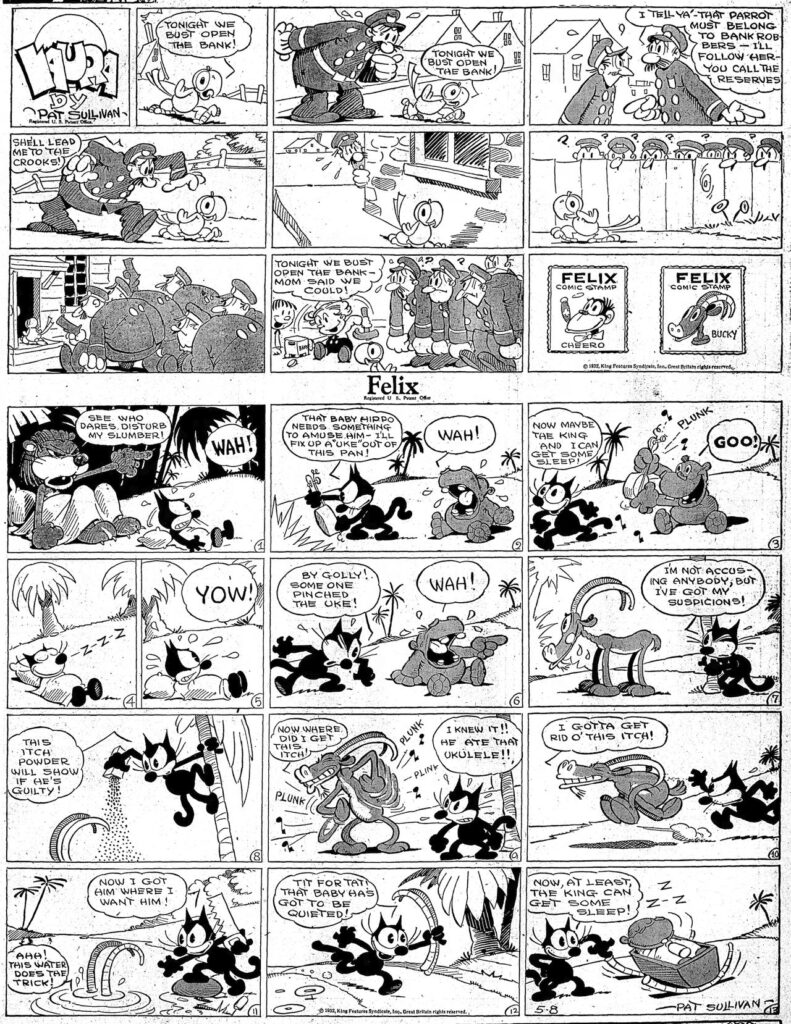
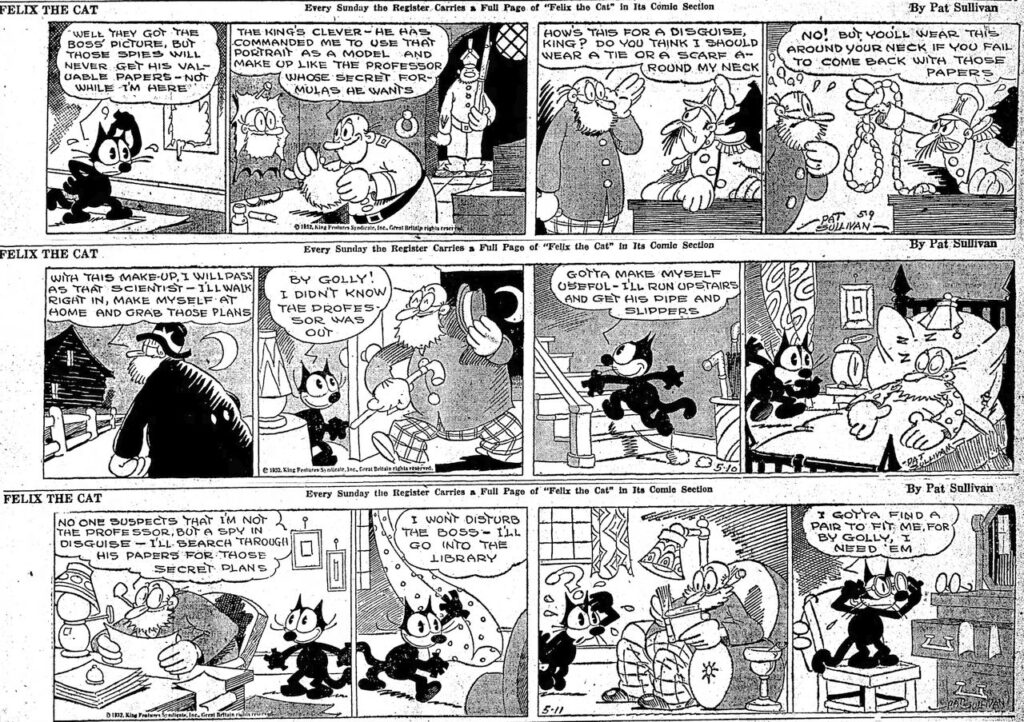
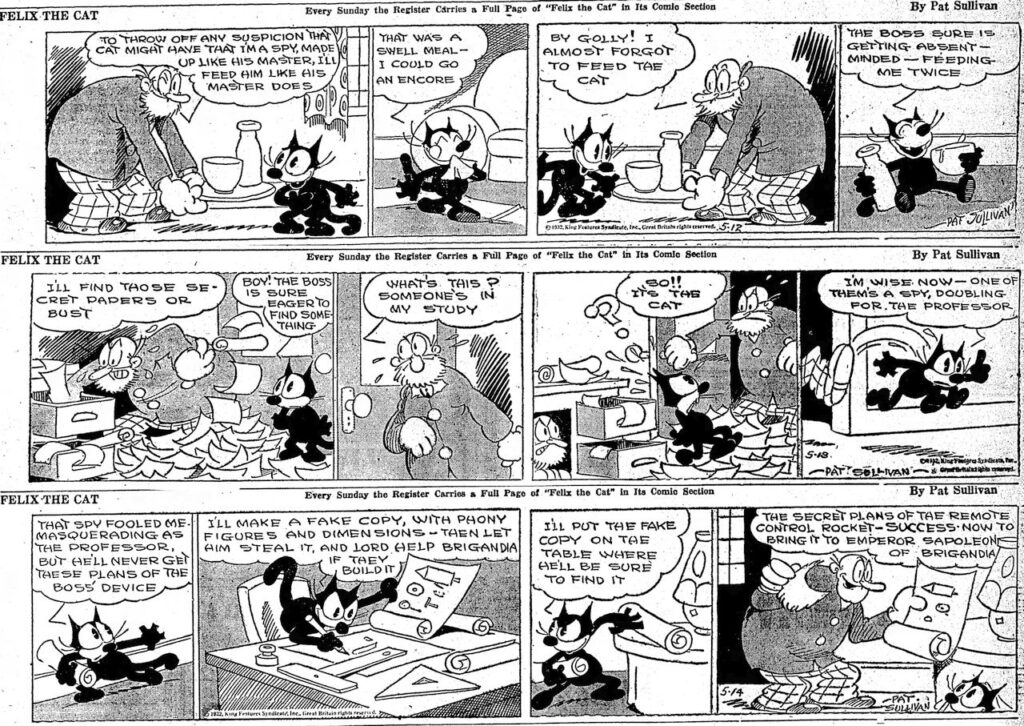
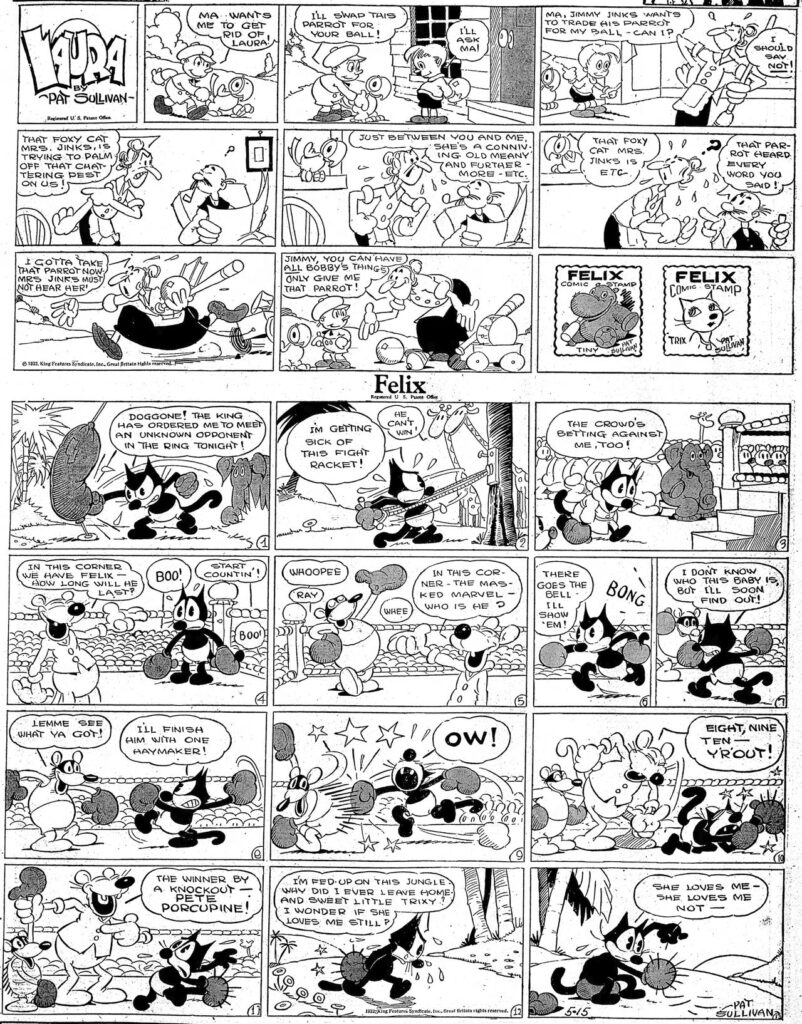
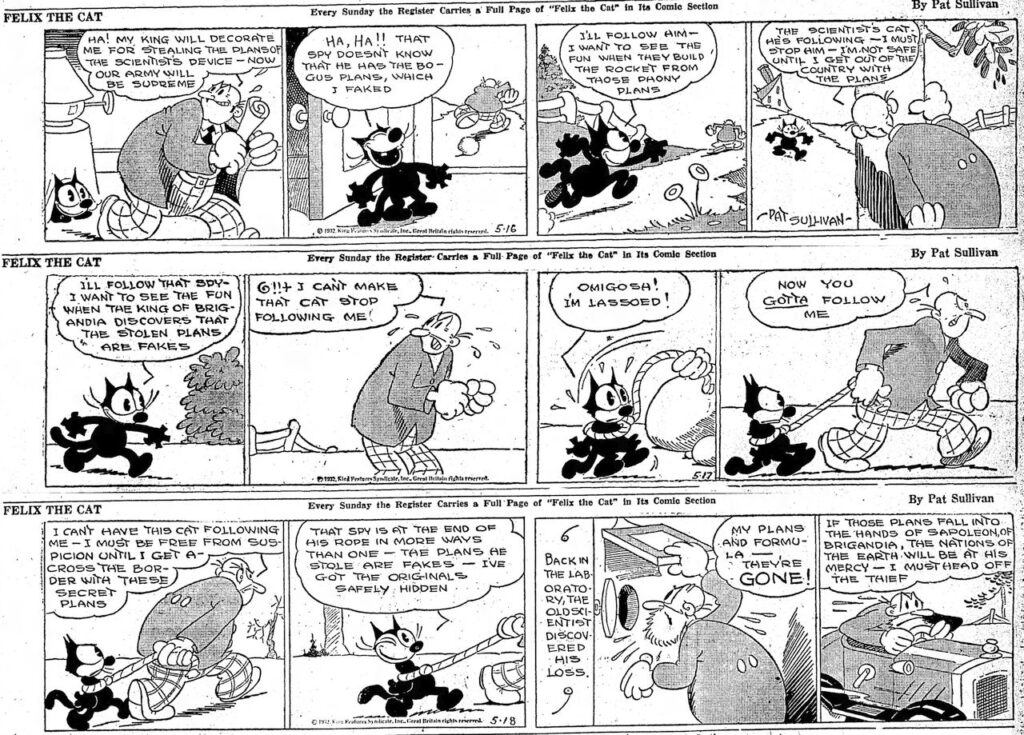
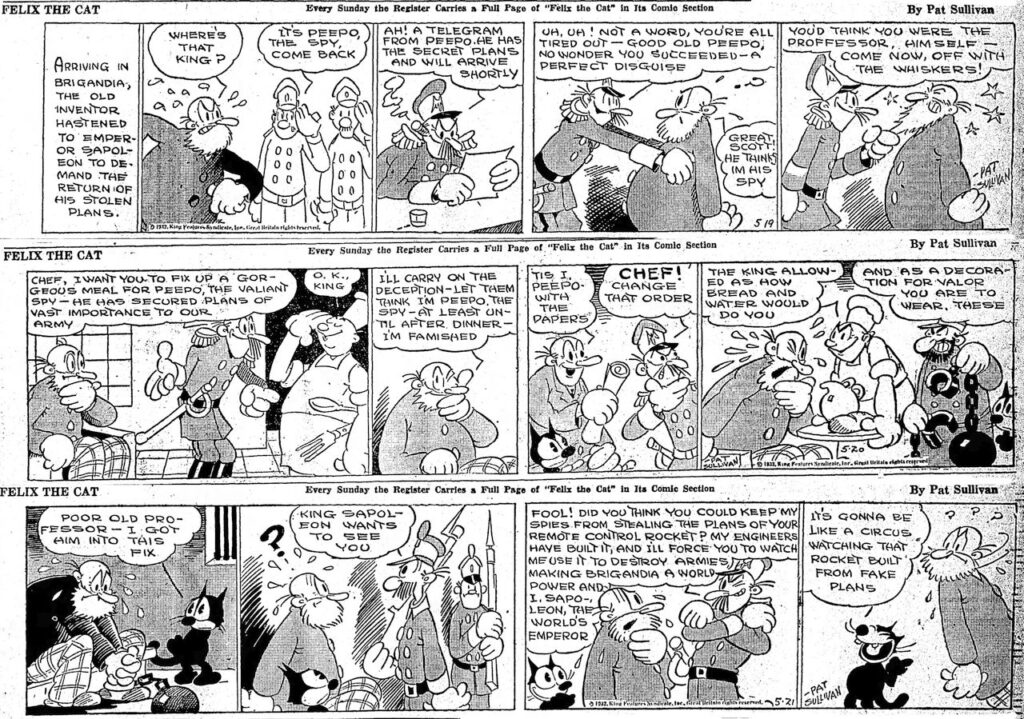

Hi Folks, Here are the Felix strips from 19320508 to 19320521 with the next chapter of the Spy story. Felix ingeniously fakes the rocket plans and slips them to the spy masquerading as the Professor. Also I’ve included our Happy Holidays card from my wife Cathy and myself. She worked out the color with Prismacolor pencils, and I did the layout and Gag. It’s a tribute in a way to Rube Grossman, a Fleischer animator who drew Rudolf for D.C. Comics in 1950. Happy Holidays to all my readers!
So Long Mabel
![]()
![]()
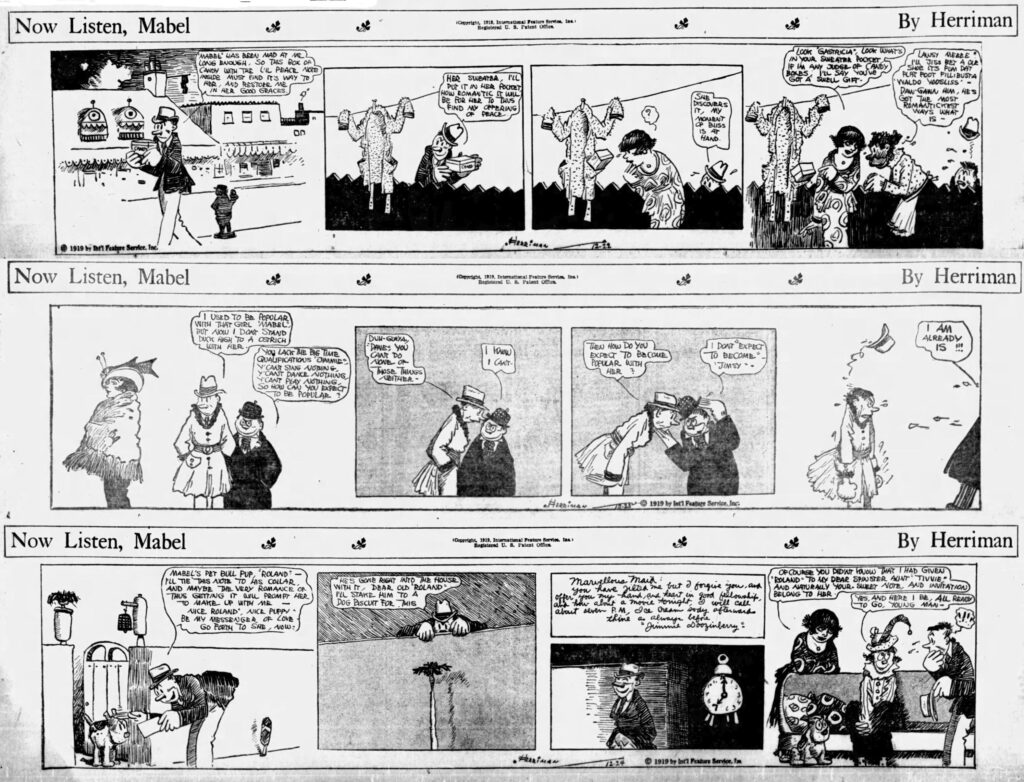
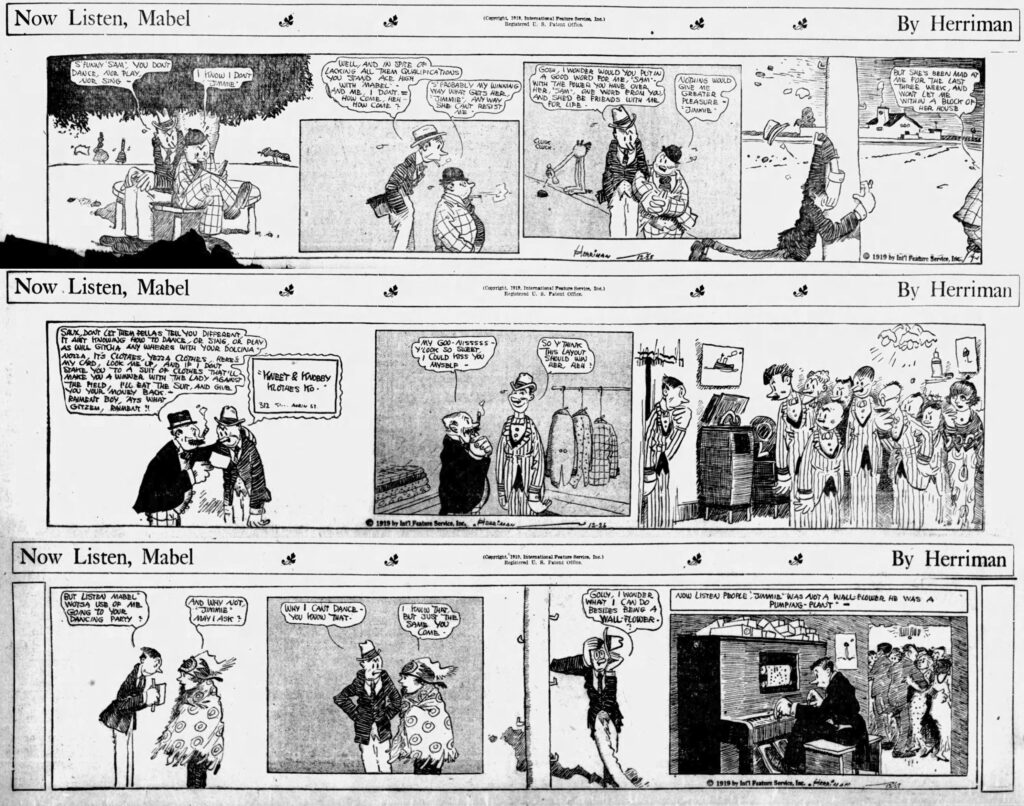
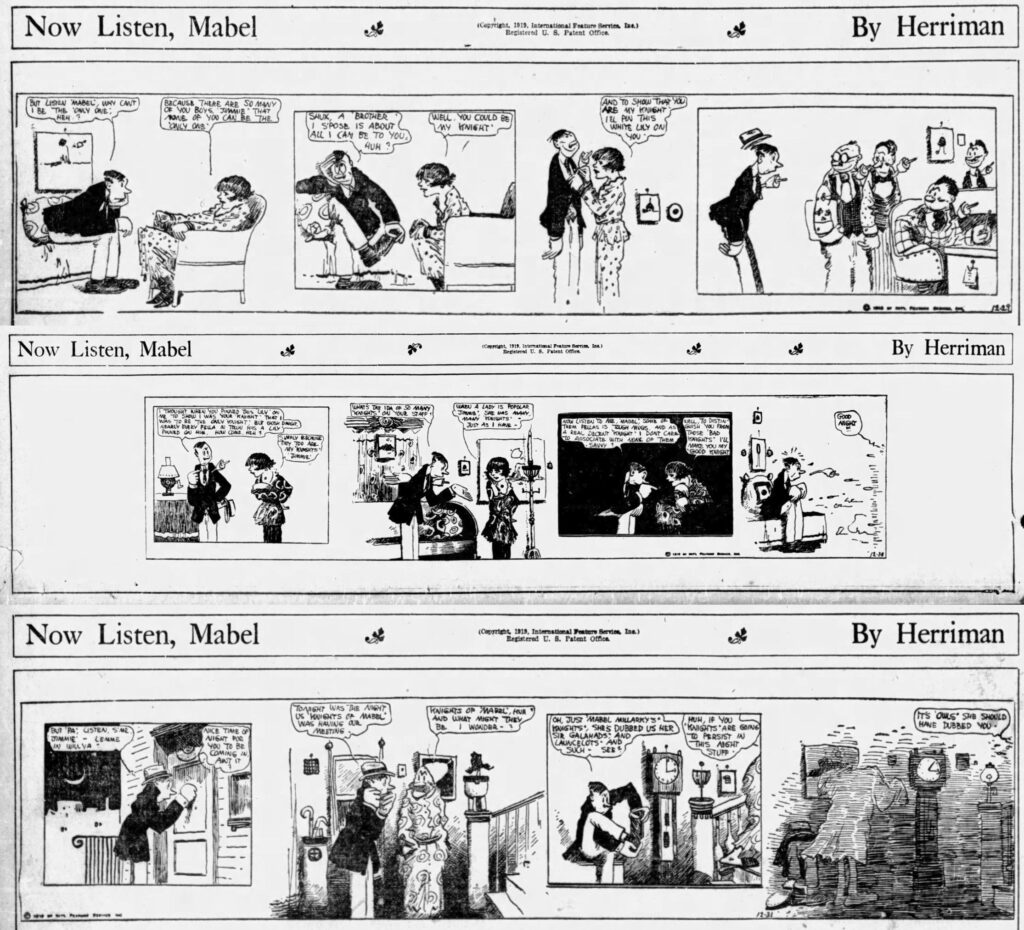
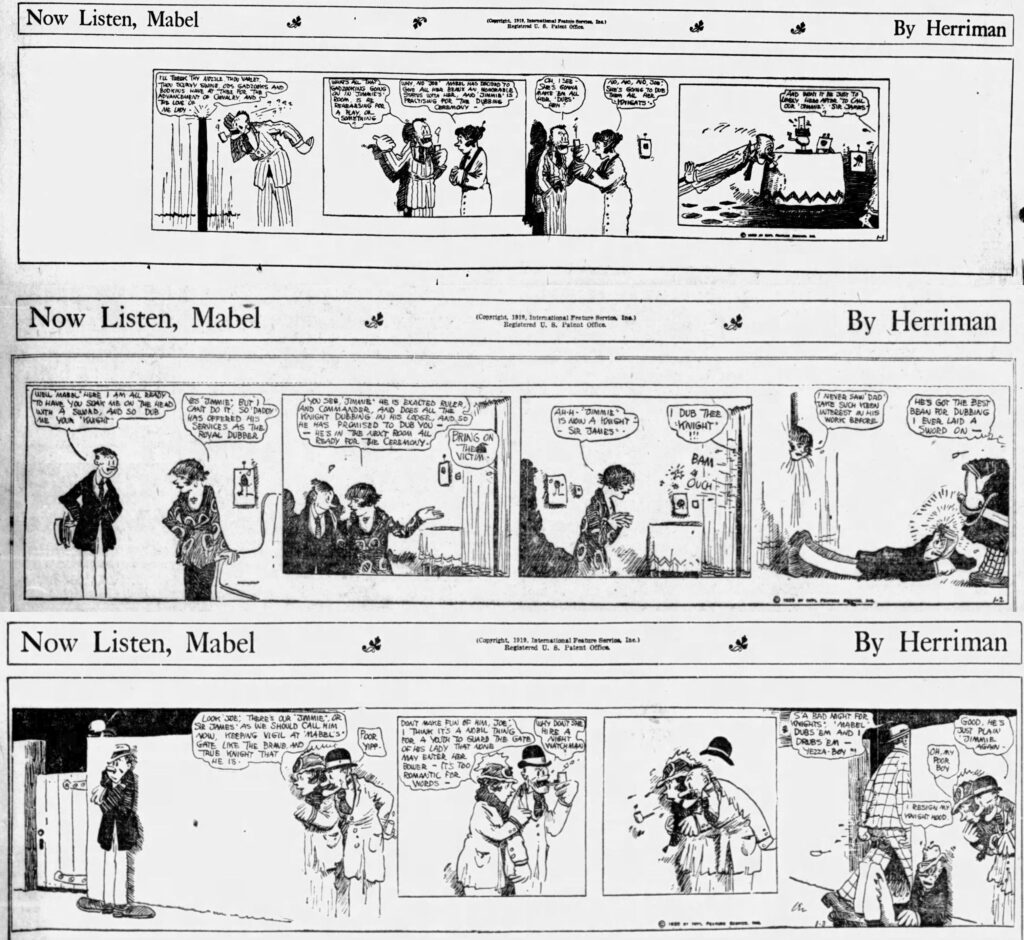

H
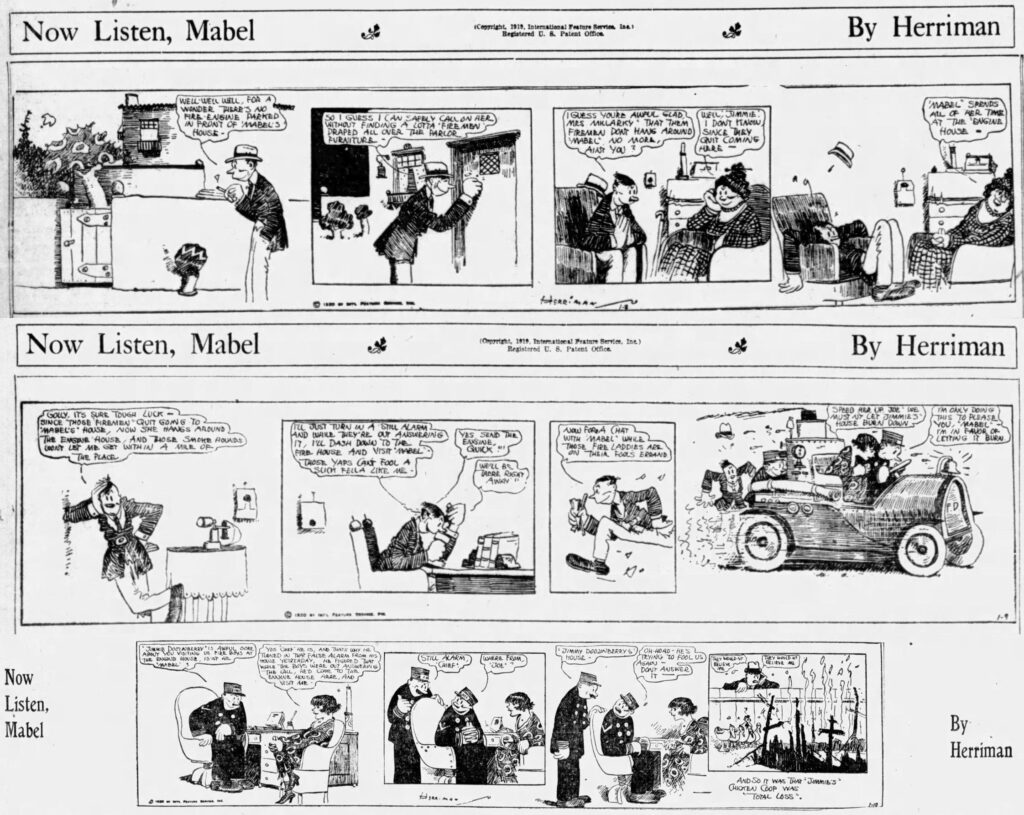
Here, as an early Christmas present, are the remaining “Now Listen Mabel” strips by George Herriman from 19191222 to 19200110. The parallels with “Krazy Kat” are even more prominent here, as Jimmie Doozinberry pursues the lovely Mabel, as hopeless a lover as Offissa Pupp with Krazy Kat. Jimmie has to constantly compete with large groups of men in these strips, such as the Police and Fire departments. Mabel just doesn’t feel comfortable with Jimmie by himself, she feels safer, and more romantic, in a crowd of guys. I wonder if “Now Listen Mabel” continued beyond 19200110 in any other papers? Allan Holtz gives the final publication date as 19191218, so now that goes down as another mistake in Allan’s wonderful “American Newspaper Comics” reference book. I can’t help but be curious about Garge’s wife, Mabel herself. Did her husband base any of the comic strip character Mabel on his wife or his daughter (both named Mabel)? Were they as big mercurial flirts and two-timers as they appear in the comics? I guess we’ll never know. So this is “so long” to the “complete” reprint of “Now Listen Mabel”, which I started back in 2021 in a post called “An End and A Beginning”. The date was 20210227. My Krazy Kat reprints stopped then, and also my blog was hacked again around that time. I hope you have enjoyed the Mabels. If any of you readers and great “strippers” find any of the early “Now Listen Mabels” that the San Francisco Examiner didn’t use, from 19190423 to 19190728, please let me know! I would love to post the missing three months. If you want to see them larger, just right-click them and open them in a new window, then enlarge them to your heart’s content. If I can’t do another post soon, then Happy Christmas to all! from Mark Kausler.
Mabel’s Cops

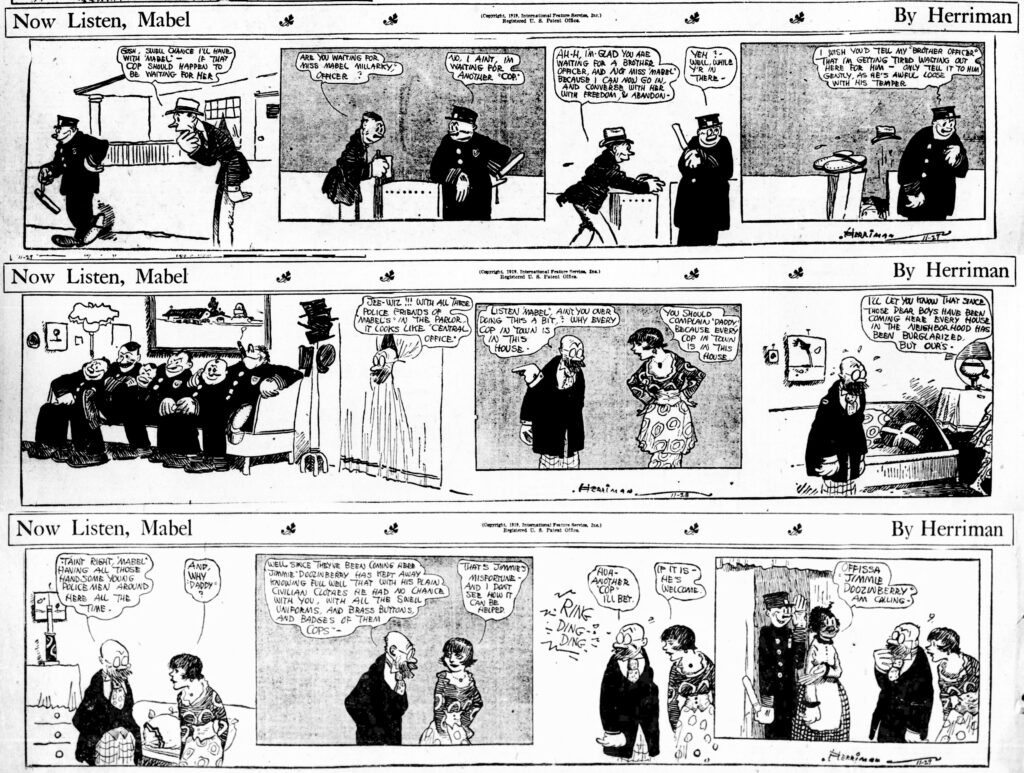
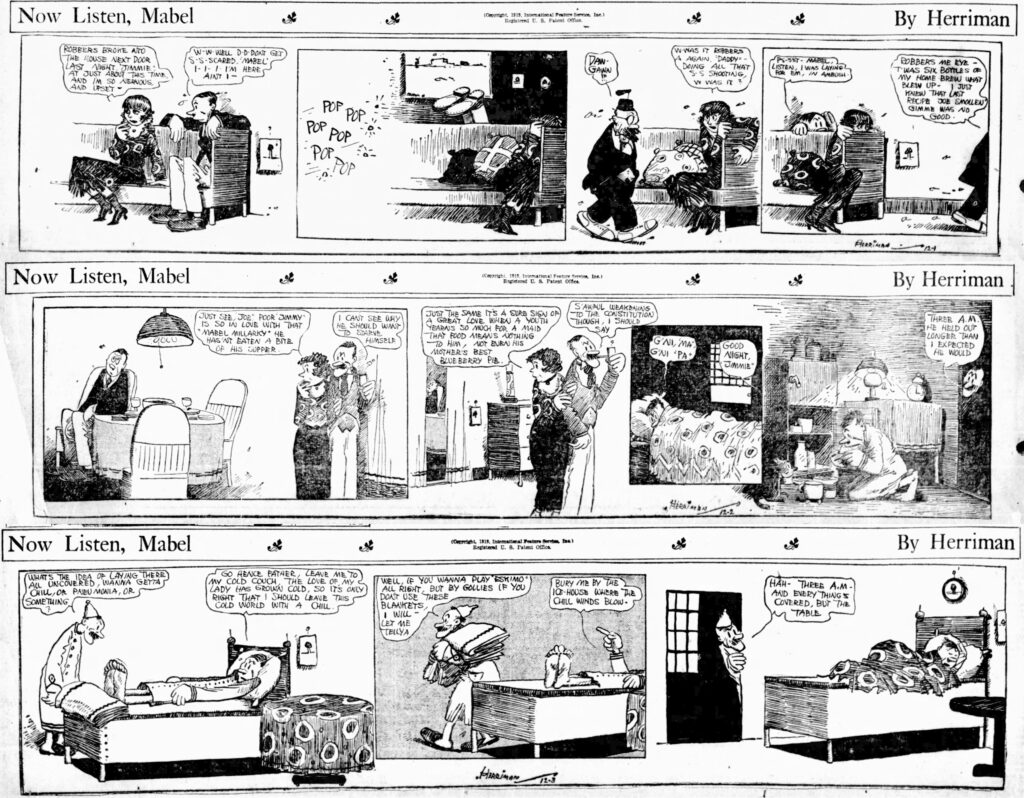
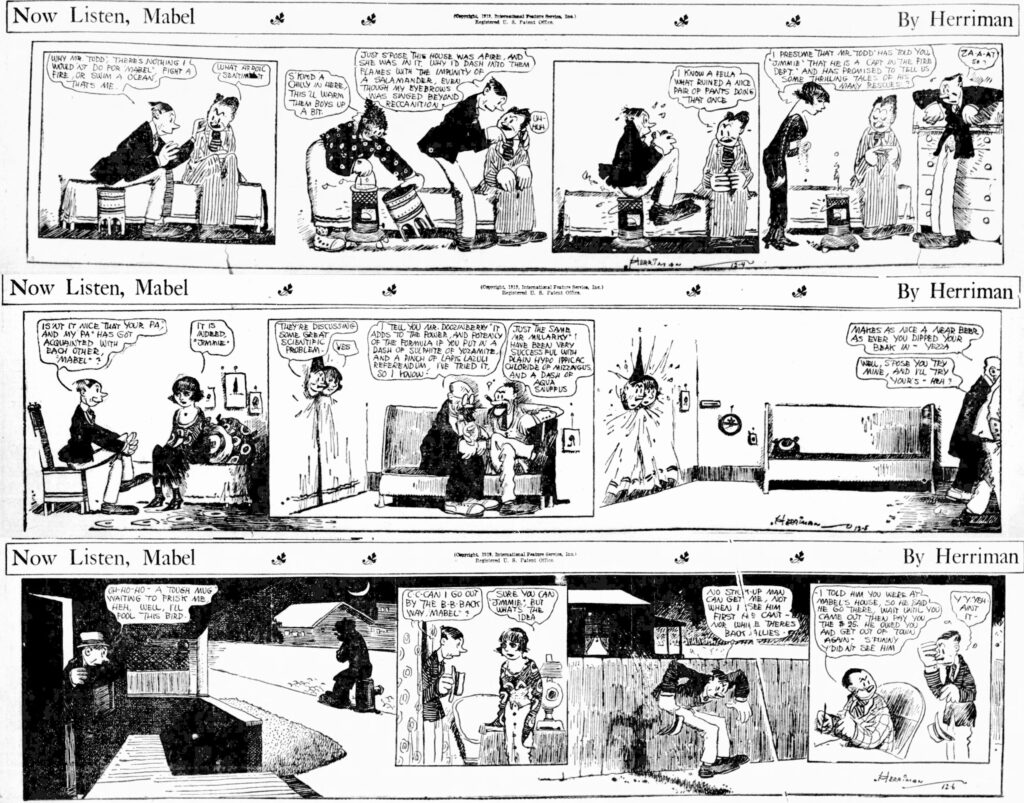
This time out the “Now Listen, Mabel” strips are from 11-24 to 12-6-1919. Jimmie Doozinberry is jealous of Policeman Tom Walsh who turns out to be Mabel’s cousin and is married. The boys from the Police station gather around the piano and sing “Ohh, Listen Mabel” to her in the 11-26. I’m not sure if “Ohh, Listen Mabel” was an actual, or Herriman-created popular song? Do any of my readers know the answer? Jimmie solves his Police problem in the 11-29 by joining the Force! Prohibition was still a joking matter in 1919 as the two dads concoct a Near Beer formula. I like the way Garge constructs the graphics on these dailies, every other panel is a floating insert, hovering over the backgrounds. Mabel and Krazy Kat both seem indifferent to their suitors at times–Jimmie Doozinberry, like Offisa Pupp, is in love with a creature who seems constantly infatuated with somebody else–Garge is using some of his Triangular Titillation in his non-Kat strips. Remember to display the strips in a new window, so that you can enlarge them for easier reading. Thanks, Mark and Itza
Felix Gets a Tail Implant
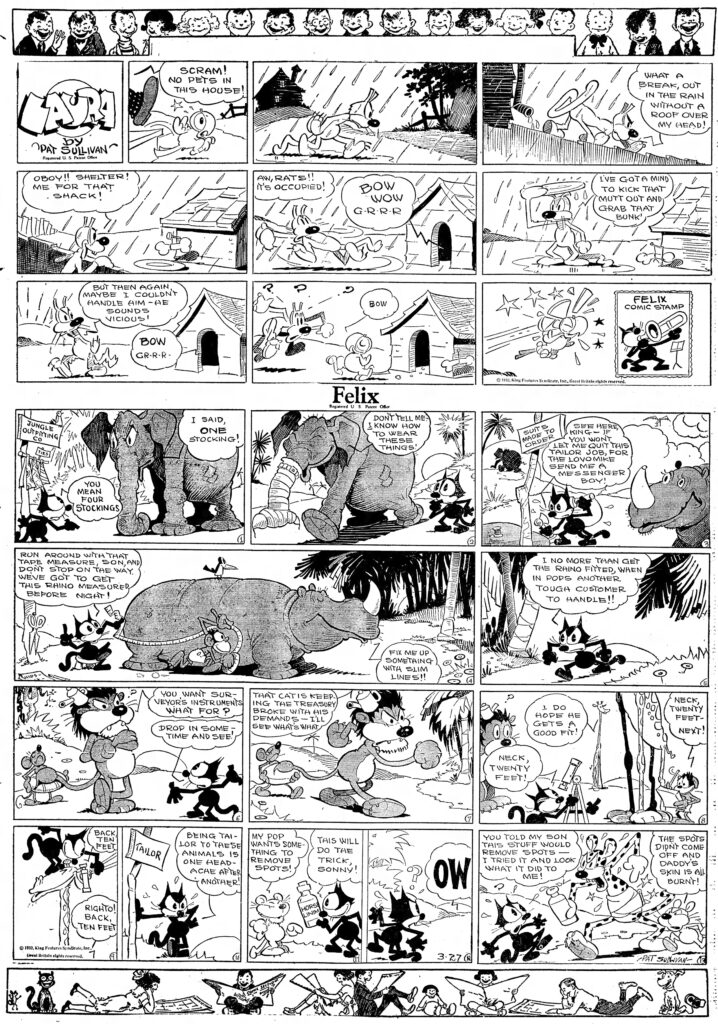
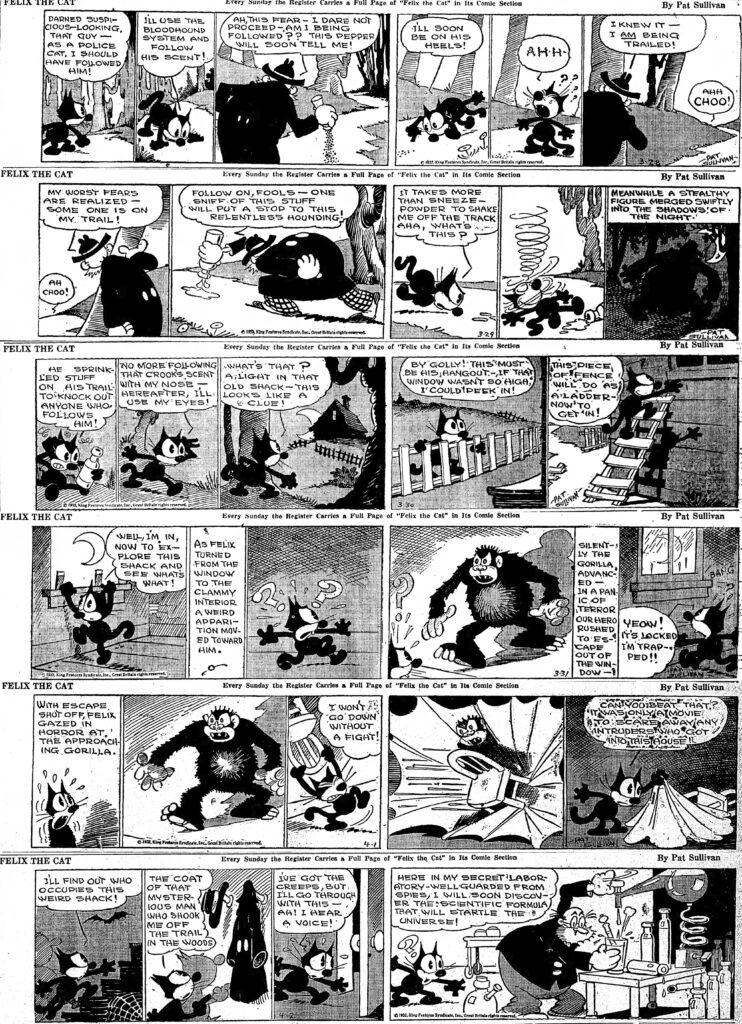


Here’s our Felix from 3-27 to 4-9-1932. Felix’s Police Cat adventures continue in the dailies as Felix trails a mysterious scientist to his weird old house in the country. The little black cat is almost fooled in to thinking that a movie of a gorilla is the real thing, then succumbs to gas. The scientist places a metallic ring on Felix’s tail which acts as a receptor for the “Mystic Waves”, which influence the cat’s emotions and enable the scientist to magnetically control Felix’s body. In July of 1932, the comedian Charley Chase made a two-reel comedy called “Now We’ll Tell One”, about a scientist who invents a belt that can transmit a person’s personality to another one wearing the same kind of belt, ten miles away. In 1934, Chase made a second two-reeler, “Another Wild Idea” featuring a scientist who invented a ray gun that had the power to transform any person into one without inhibition. So Charley Chase picked up on an idea from the Felix strip, and formulated two film comedies out of it. This idea of the tail implant, and the impact it had on Felix’s personality, was used a few times in the Felix comic books of the 40s through the 1960s. I think, though, that this was the earliest appearance of the basic idea of mechanical alteration of the personality in the Felix comic strip. Today, the descendants of Otto Messmer might be tempted to plant A.I. in Felix’s body, and use it for the same type of gags. The Sunday pages continue Felix’s adventures with the Noah’s Ark animals on a tropical island. Enjoy these, the best drawn and designed Felix strips of the Golden Age! Mark
Mabel Listens Again
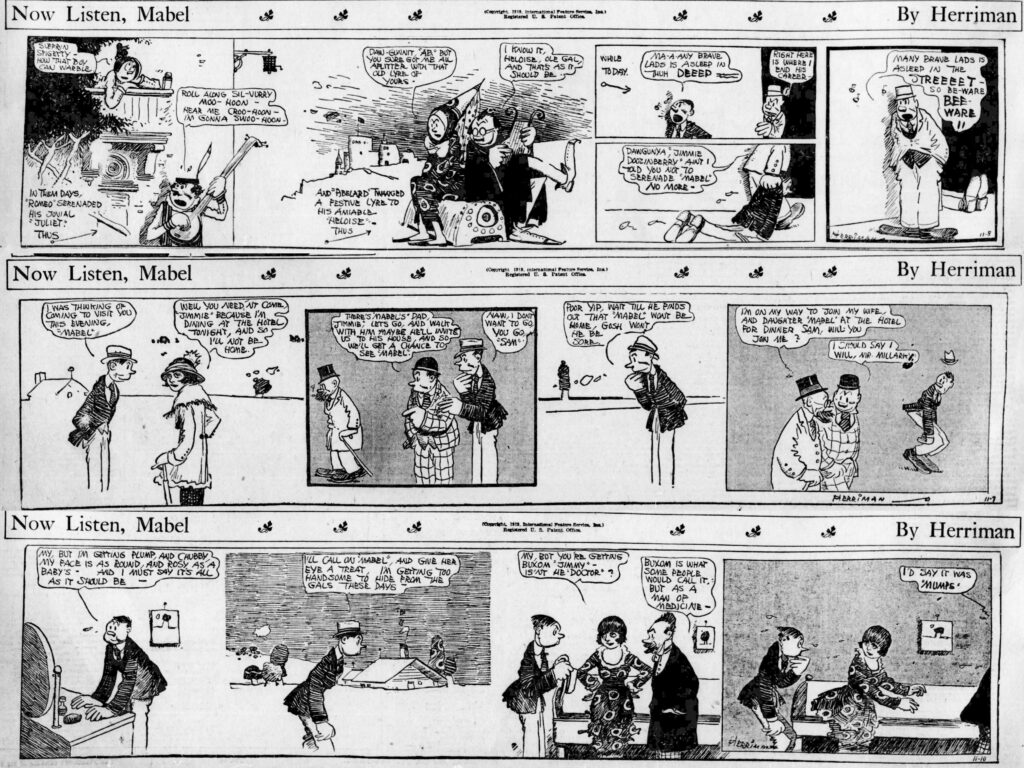



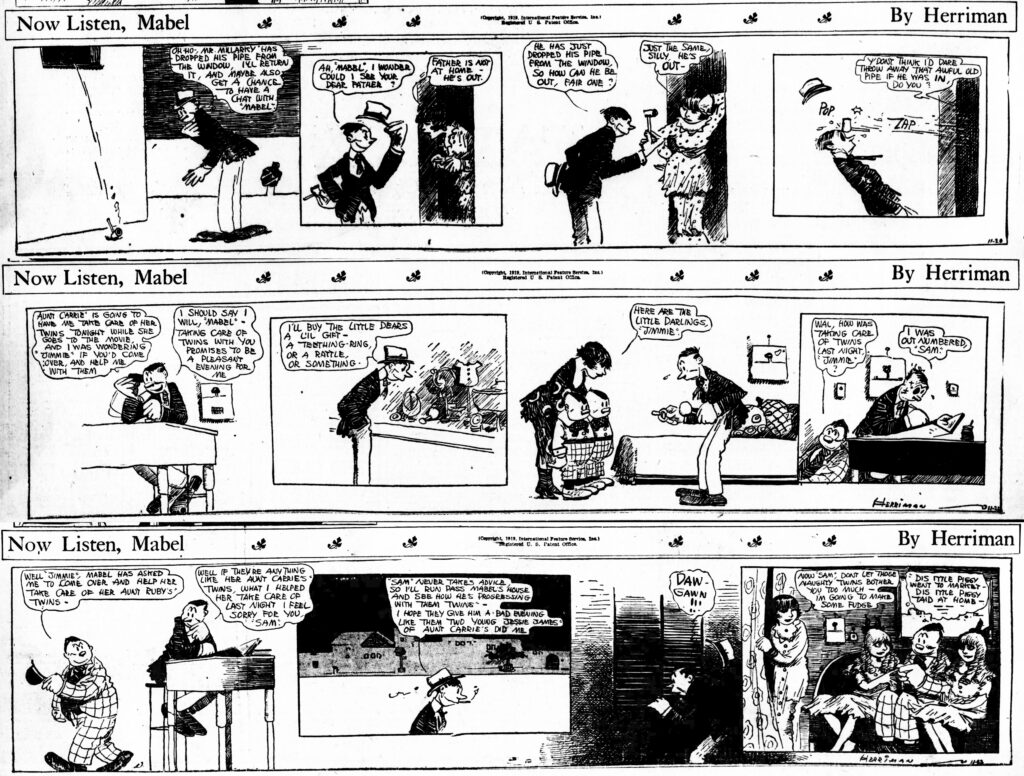
In the words of Bill Hay, “Here they ah!” The “Now Listen Mabel” dailies from 11-8 to 11-22-1919. In the 11-8 there are human figures in the first two panels that anticipate the characters in the illustrations to “archy and mehitabel” which Garge produced in 1931 for Don Marquis’ epic poetic volume about his New York Sun characters archy the cockroach and mehitabel the cat. Starting in the 11-10 strip, Garge writes about an epidemic of Mumps which manages to infect almost everyone in the cast of the strip, starting with Jimmie Doozinberry. I can’t find any record of a Mumps surge in 1919, but the disease goes back to the 5th Century BC at the time of Hippocrates. The virus was not isolated until 1945 and the first vaccine didn’t appear until 1967. So Jimmie and Company got Mumps before very much was known about it. Seems like nobody panicked, they just put up with the swelling until it went away. There was an early link between Mumps and deafness. Garge just used it for comedy.
In the 11-17 through 11-22 strips, “Mabel” feels like a precursor to “Blondie” situations. Floods, vicious dogs, smelly pipes and one of Garge’s favorite comedy crutches, “Twins” and the damage they do, along with mistaken identity jokes. I like Jimmie’s reaction to his pal Sam’s luck in babysitting Mabel’s Aunt Ruby’s twins. They turn out to be attractive teenagers!
Enjoy these, I hope I can post more soon. The strip only ran another two months in the San Francisco Examiner.
Felix Foils an Umbrella Thief
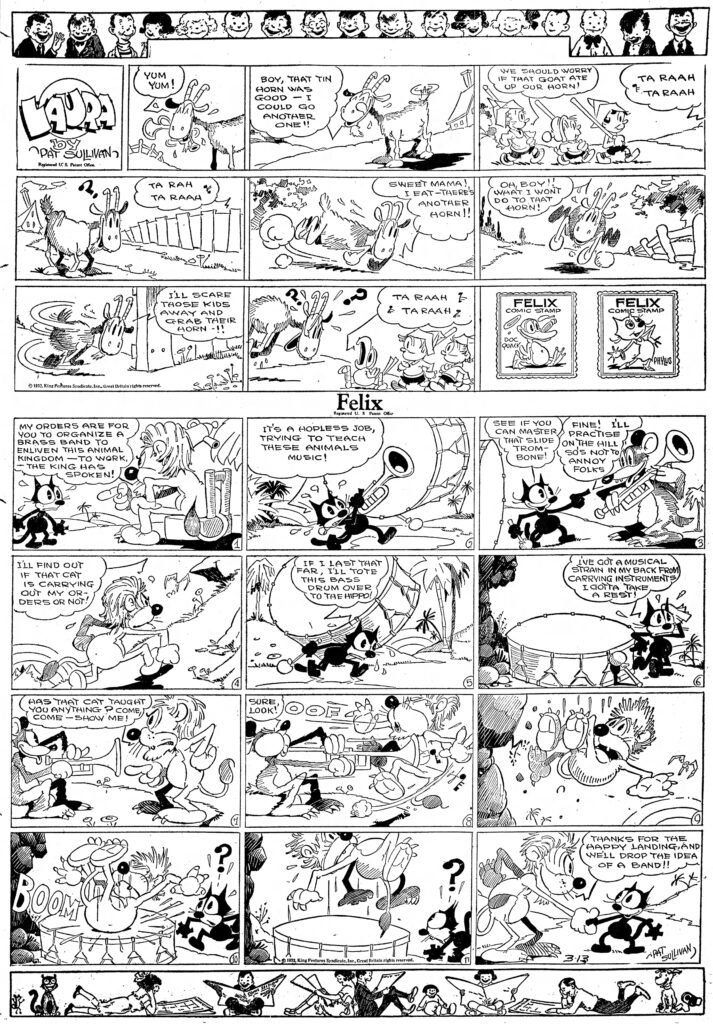
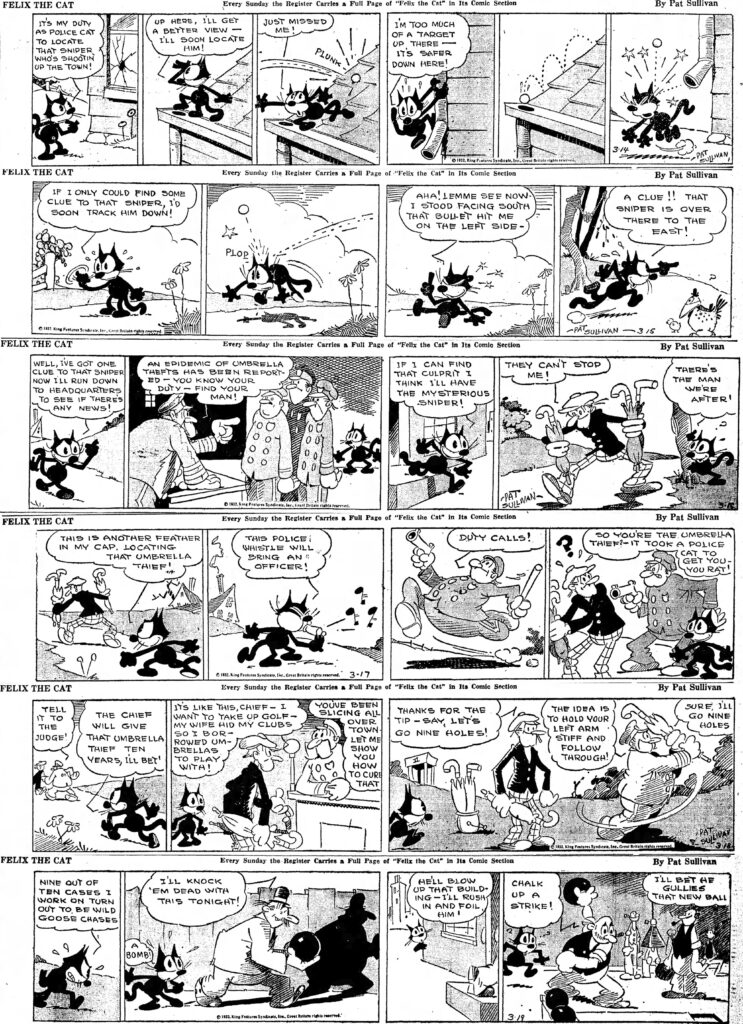
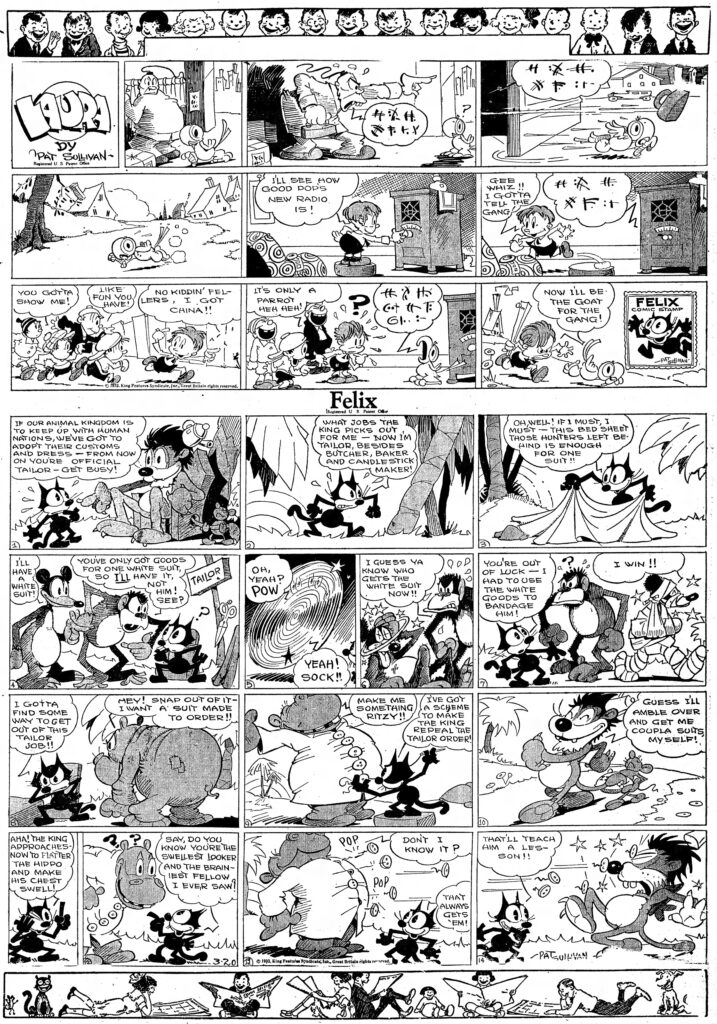
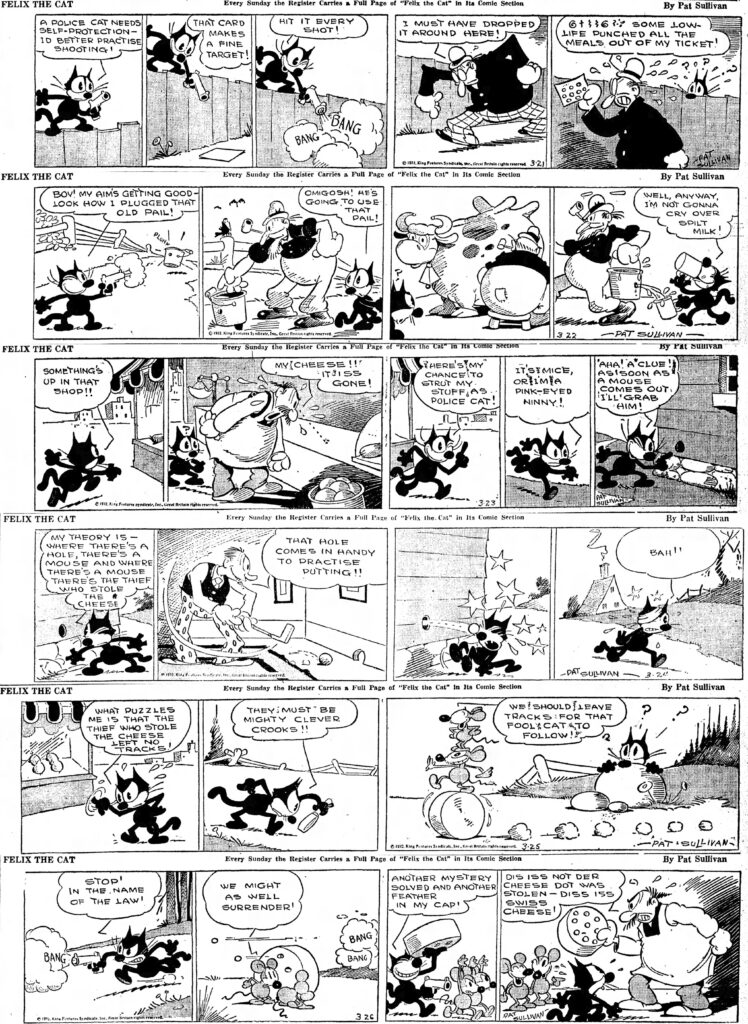
Welcome back readers, as we present the Felix the Cat strips from 3-13-1932 to 3-26-1932. Felix is still a Police Cat Detective in these, trying to locate a sniper who is actually an umbrella thief who is using the umbrellas for golf clubs. In the 3-21 through 3-26 strips, Felix solves a cheese theft as Skidoo and his friend steal a whole wheel of cheese from a Nordic accented proprietor. It doesn’t pay to use guns, as Detective Felix shoots at Skidoo so many times that his shots penetrate the cheese wheel. The bullet holes leave the wheel looking like Swiss cheese, much to Detective Felix’s chagrin. I love the art all the way through these, but my favorite panel would have to be the last one of the 3-22 daily. There’s something very comical and appealing about Felix drinking milk from a punctured pail (Otto’s cow isn’t too tragic either). The old Catblog has been shut a long time, I hope it will be back in action before too long. See you then, Mark
George Herriman Returns!
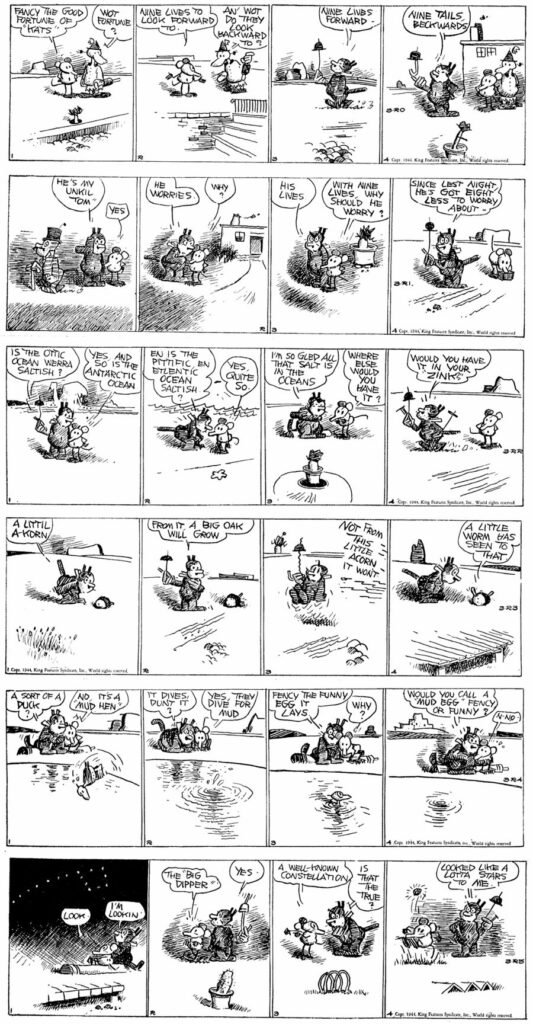 George Herriman is back at the drawing board, these are some of his last comic strips. The dates are 3-20-1944 to 4-15-1944. The writing harks back to the original Krazy Kat dailies from 1913, not only gag-a-day, but vaudeville style gags, delivered from the Coconino County stage.
George Herriman is back at the drawing board, these are some of his last comic strips. The dates are 3-20-1944 to 4-15-1944. The writing harks back to the original Krazy Kat dailies from 1913, not only gag-a-day, but vaudeville style gags, delivered from the Coconino County stage.
Notes on the strips: 3-31-1944: This works as a two-way pun, “sole” and “soul”.
That’s the notes for this time, my faithful readers. I shall return soon with another month’s worth of 1944 George Herriman. Happy New Year, and I hope your quarantined Christmases were warm and bright. 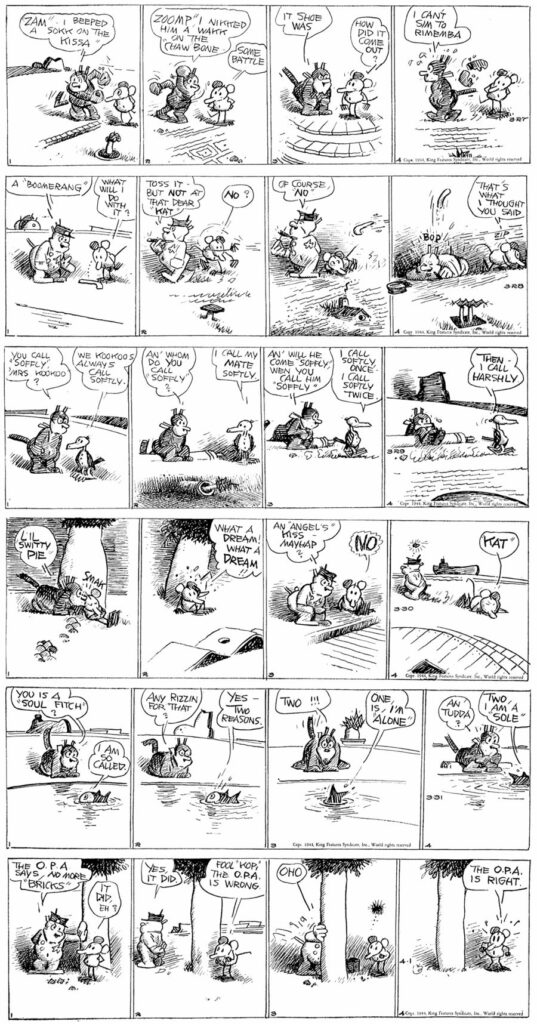
I’m learning new skills as taught to me by my WordPress advisor. I’m trying to learn how to embed videos. I love this early Charles Mintz Krazy Kat cartoon, and the silent one that follows it. Click on the arrow in the center of the frame. Enjoy!
Krazy Kat Bob Naylor Special
Here’s a whole month of Bob Naylor’s version of Krazy Kat, all signed Herriman. These originally appeared from 2-21 to 3-18-1944. These strips are pretty good, they represent Herriman’s spirit well, and Naylor has the personalities of the characters “Nayled” (sorry). You’ll notice that the gags mostly center around bricks and Offissa Pupp putting Ignatz in jail. Even Kolin Kelly appears. In Herriman’s 1944 strips, the brick tossing is mostly implied, not shown. Ignatz often ends the strips by starting to pick up a brick, but not actually throwing it. Herriman starts introducing other characters, dogs, birds, and so forth. But Bob Naylor has reverted back to the earlier days of “Krazy Kat”, with the original cast. The strips from 3-13 to 3-18-44 all refer to “frozen” bricks. This is a reference to World War Two rationing, in which products were “frozen”, in other words, no longer made. “Frozen” also referred to fixed price controls during the war. Here, Naylor makes humorous comparisons between frozen products no longer made, and frozen products literally sold from an electric freezer. In 1944, fresh frozen foods, such as orange juice, were just starting up. It took until 1945 and post war years, for frozen orange juice to be perfected so that it tasted good and households could afford electric freezers. So this storyline by Bob Naylor is quite futuristic, wouldn’t you say?
I’ve been having a lot of trouble with WordPress lately. A lot of the image displays are distorted vertically, and I don’t know how to fix the problem. Can any of my WordPress expert readers help me? I am willing to pay you if you can fix the distorted images. In the meantime, just right-click on the image, select “View Image”, and the picture displays in normal proportions. Sorry to make my readers and viewers work so hard to use my blog, but that’s the way things are for right now. If you want to blow these comics up to full screen, just right-click the image, select “View Image” to put it in to a new window. Then press “Crtl” and press the “+” symbol repeatedly. The image will enlarge to the limit of your system’s settings. Enjoy, sorry it’s been so long since the last post.
Your Comics Page 5-17-2020

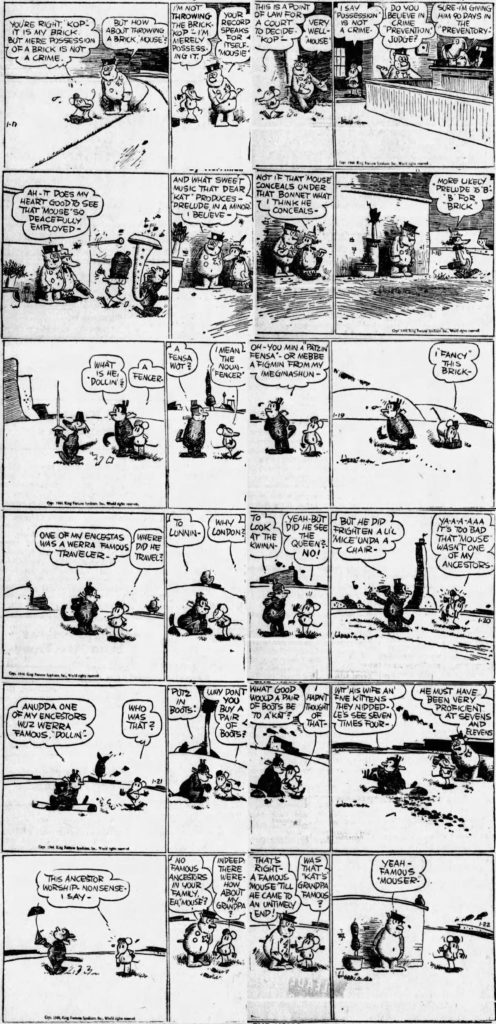
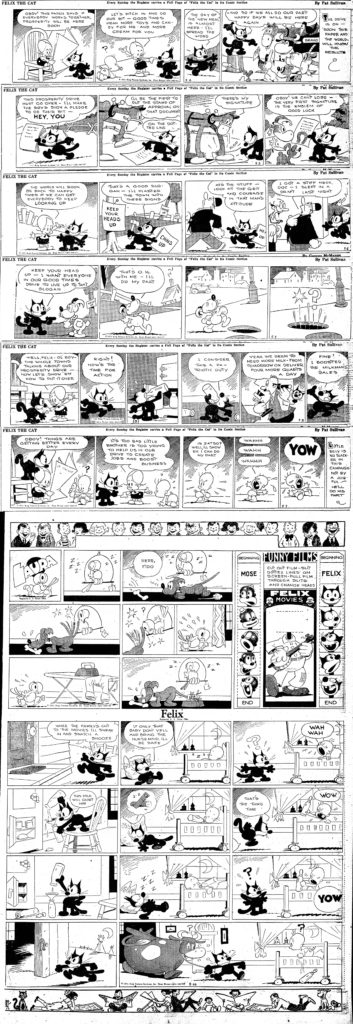
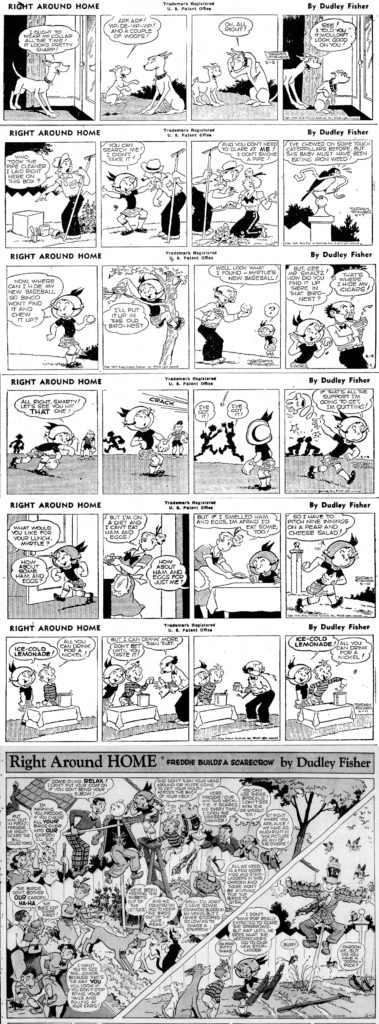
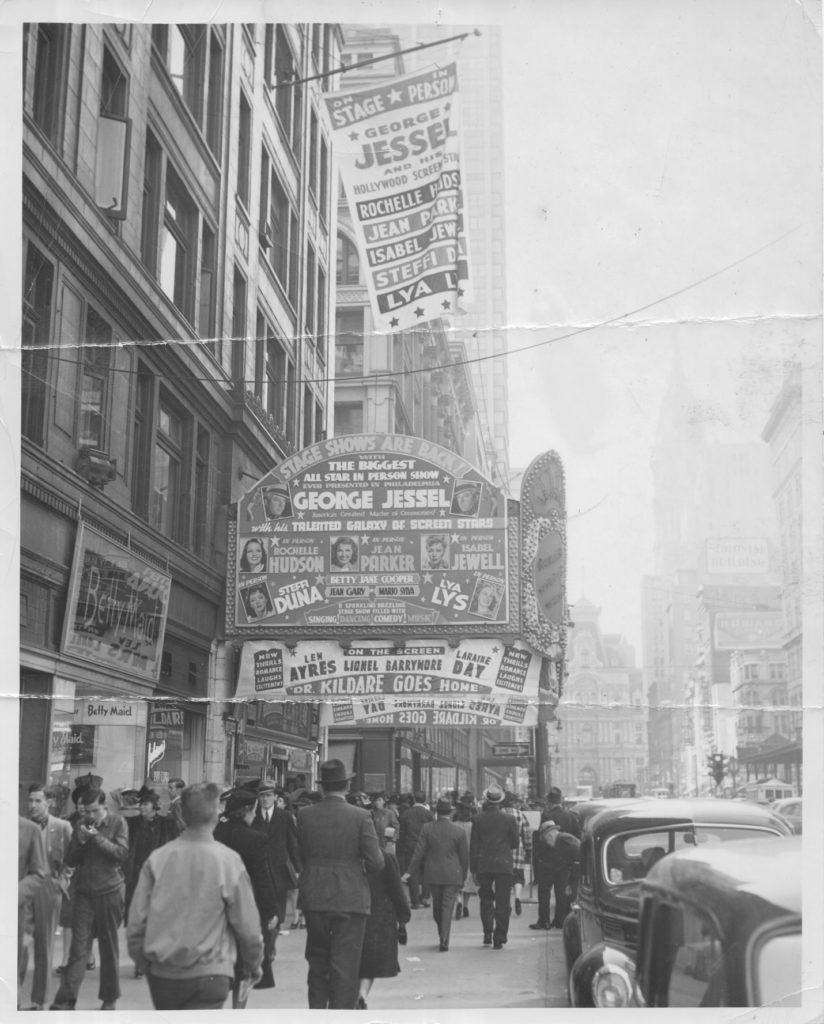
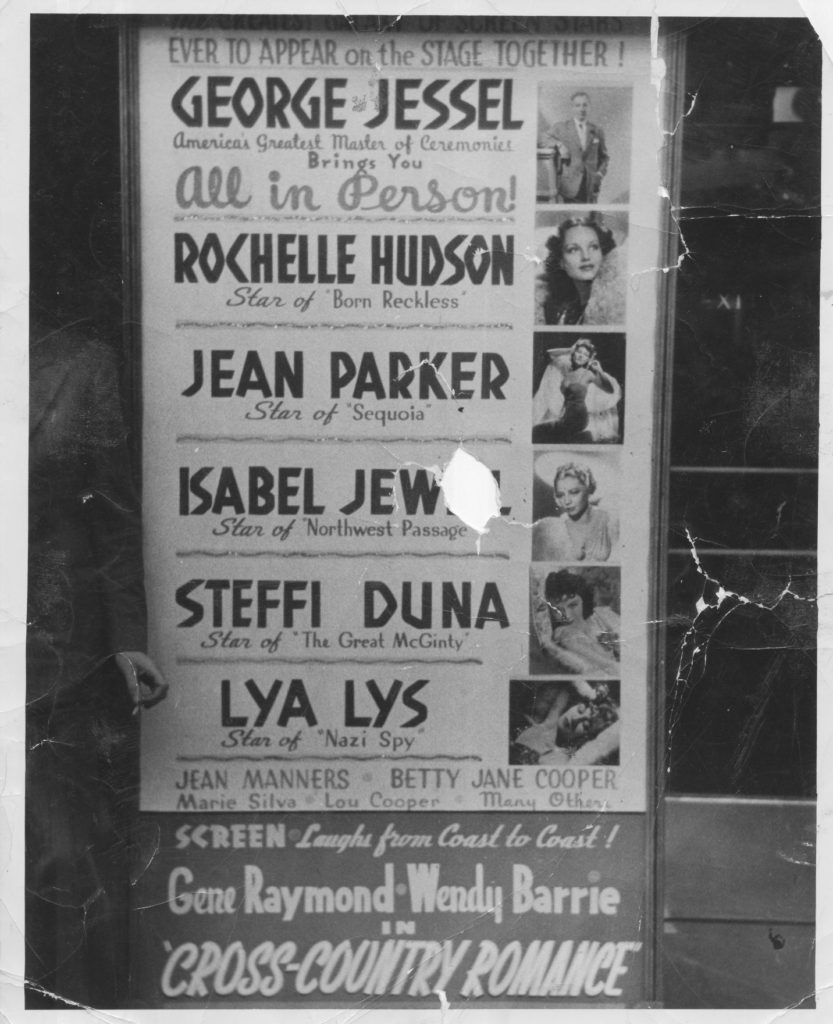
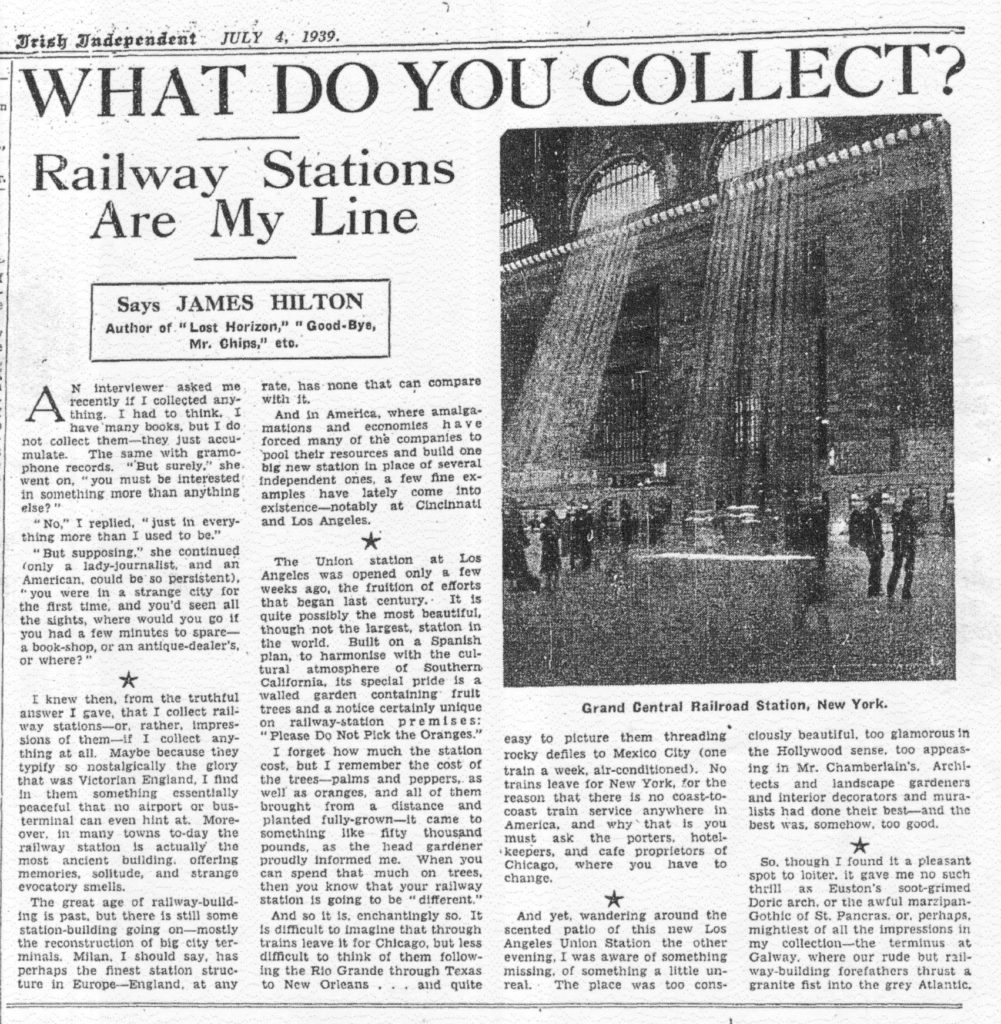
I hope you are all making like Zorro and The Lone Ranger these days and masking up for your peregrinations around your neighborhoods. This Covid-19 virus puts the damper on a lot of things, but not in the sharing of comic strips and remembering my dear brother. Stay safe, oh my readers! So sorry it’s been so many months since the Catblog meowed!
Your Comics Page 1-22-2020
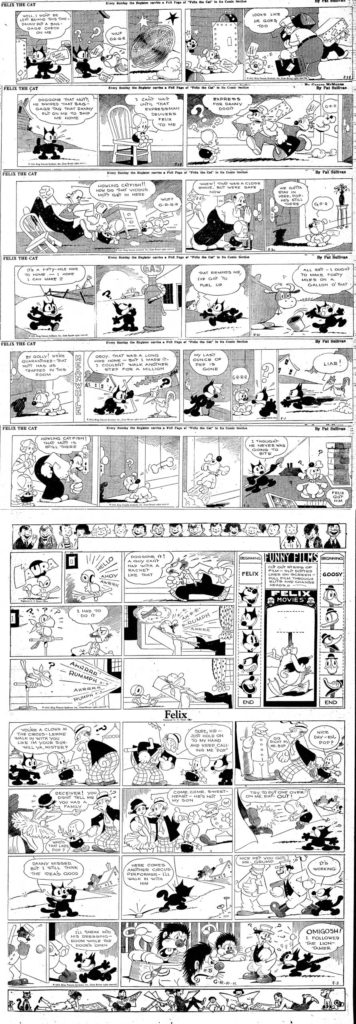
Here’s Felix from 8-28 to 9-3-1933. Felix is confused with a mean Bulldog in a boxcar freight mix-up. The Bulldog holds Danny Dooit and his family hostage in their home until Felix saves the day with a fishing pole. In the Sunday, the Circus story continues as Felix and Danny try to sneak in to the show with disastrous results. Don’t the lions recognize Felix as a fellow cat?
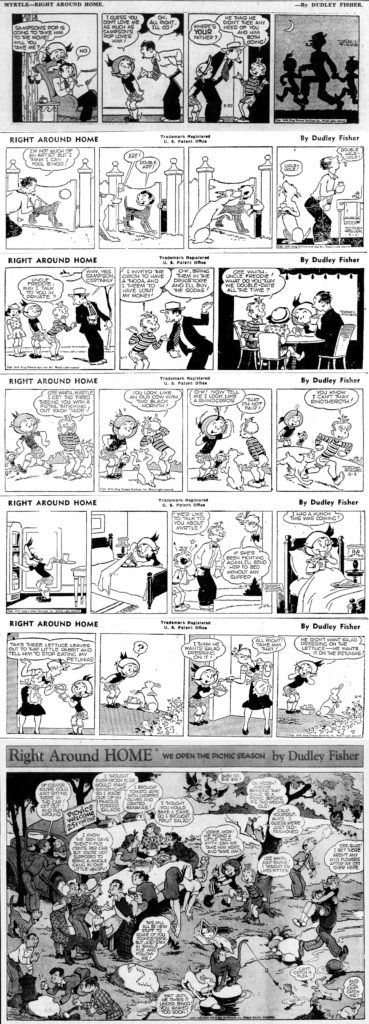
Here’s Dudley Fisher’s Myrtle from 5-30 to 6-5-1949. My favorites from this batch are the 6-2, in which Sampson rearranges Myrtle’s braids so that she looks like a “rinotheroth”, and the 6-3 in which Myrtle plans on being sent to bed without supper for beating up Sampson! The Sunday page shows the start of the Picnic Season as Myrtle and Sampson scare Susie right out of her shoes by presenting her with a “little wild kitty” that looks very much like Hyacinth with skunk stripes. I like the little detail in the lower left hand corner of the men trying to light a campfire with their cigarette lighters.
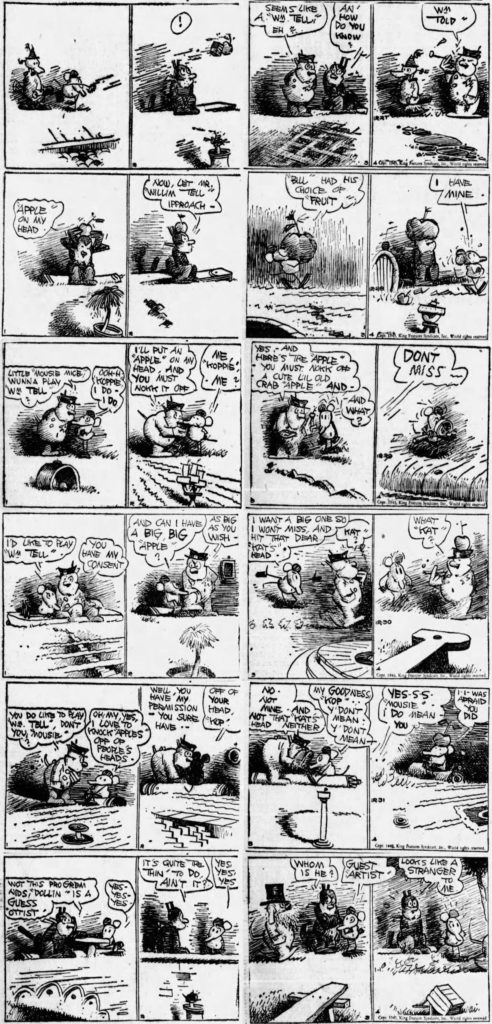
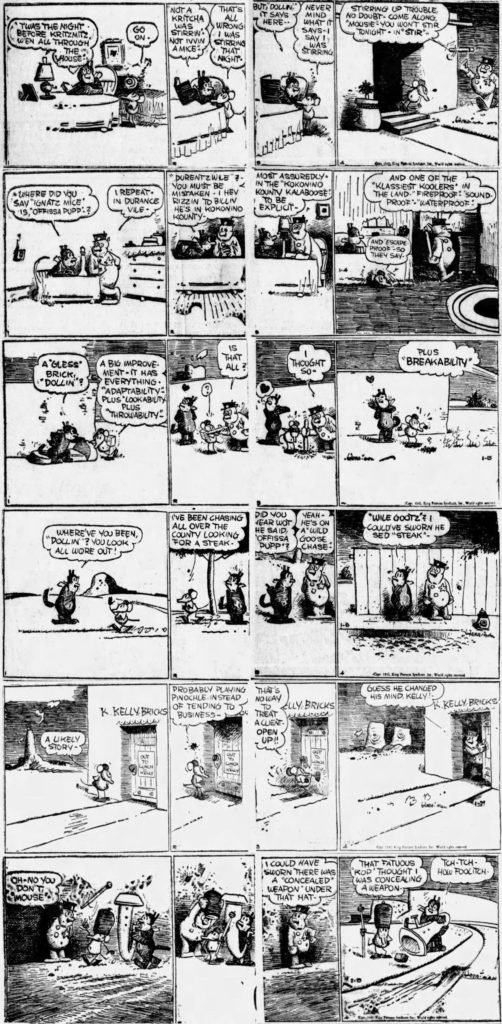
Here’s the start of the final six months of “Krazy Kat”. The last week of 1943 through 1-1-44 is the work of George Herriman. He foreshadows the week of 1-2 to 1-8-44 in the strip for 1-1-44, as Krazy says “Wot this progrem nids is a guess artist”. And starting 1-2-44 that’s just what the strip gets. Garge was not well in January of 1944 and had to be hospitalized for what he called “dropsy”. Today we call it edema. So an old friend of Herriman’s pinch hit for him on Krazy Kat. You will note that all the comics from the first week in 1944 are carefully signed “Herriman”. Garge did not and had not signed his dailies for many weeks prior to 1-2-44. He didn’t sign any of the 1943 Sunday pages, and signed only four Sundays in 1944. So I think it’s a good bet that when Herriman’s signature appears on a 1944 daily, it’s the work of the “guess” artist. The “guess” artist went back to the late thirties for his models of the characters, perhaps tracing them. The lettering and balloons are a bit too neat and regular to look like Garge’s work. These strips are quite possibly the work of Bob Naylor, who worked with Herriman on the “Embarrassing Moments” panel cartoon of the early 1930s. Naylor could imitate the Herriman style quite well and also submitted gags which Garge used for the panel. He also drew the “Barney Baxter” feature in the late 1940s. If any one of you readers knows that Bob Naylor did NOT draw the KK dailes in 1944, please leave me a comment!
Herriman’s art was beginning to look a little shopworn in the last strips of 1943. Krazy’s head nearly looks like it’s melting in the first panel of the 12-28-43 strip The last panel of the 11-30 looks like Offissa Pupp and Ignatz are disappearing into the page as Garge uses his knife to scratch off the ink lines. He uses a similar technique in the last panel of the 1-1-44 strip as Krazy says “Looks like a stranger to me”, as the “Guess Artist” walks through the strip. Krazy nearly looks transparent in the panel.
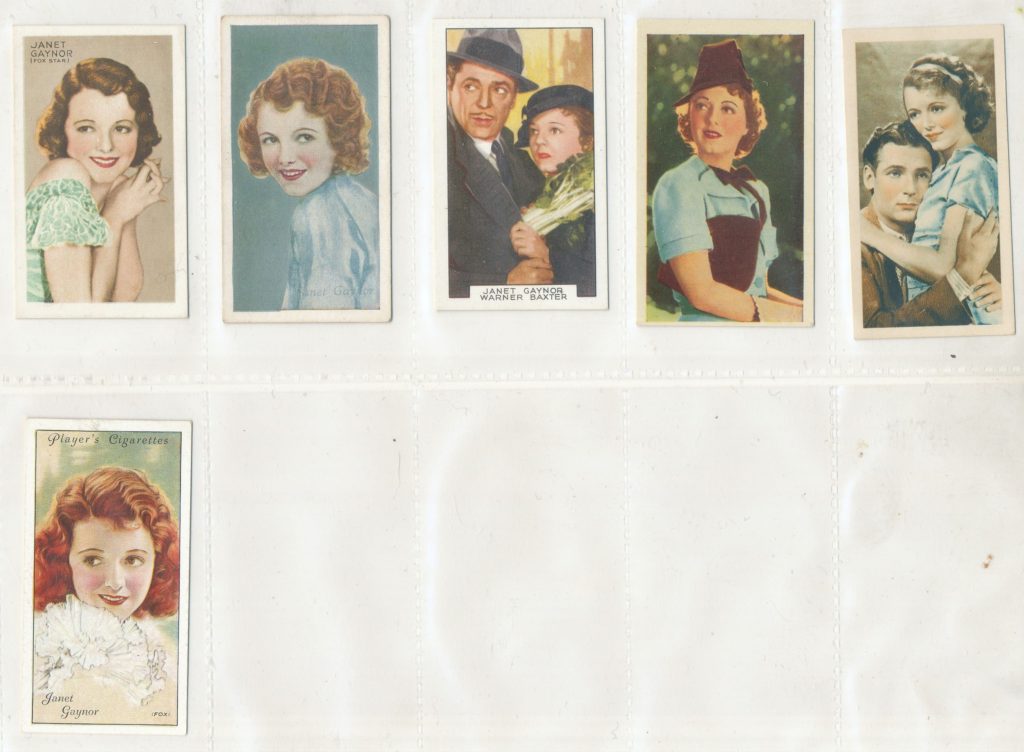
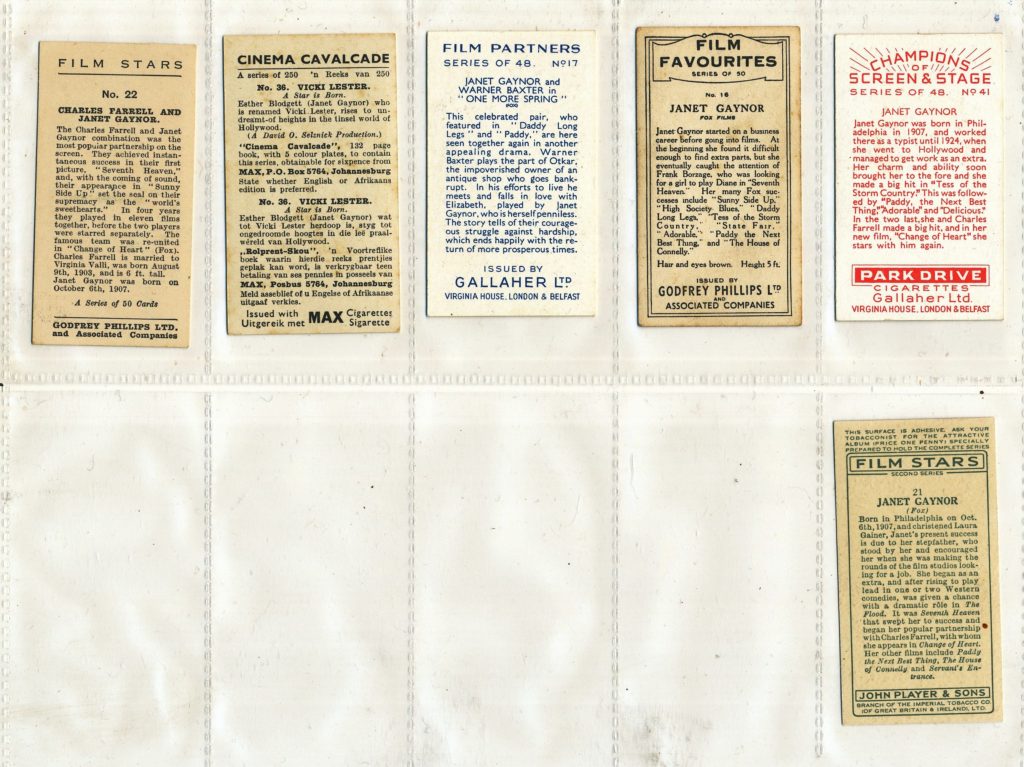
In the ongoing tribute to my dear brother who passed away nearly a year ago, I present some more treasures from his collection of vintage movie stills. Above are color cigarette cards featuring Janet Gaynor who was in “Sunny Side Up” (1929) and starred as Esther Blodgett in “A Star Is Born” (1937). In the heyday of cigarettes, colorful little cards likes these were wrapped up in the cellophane that protected the packs. I think that Janet Gaynor had an influence on the character of Snow White. The two ladies have similar faces, and Snow White’s personality may have been based on the sweetness of Gaynor’s screen character.


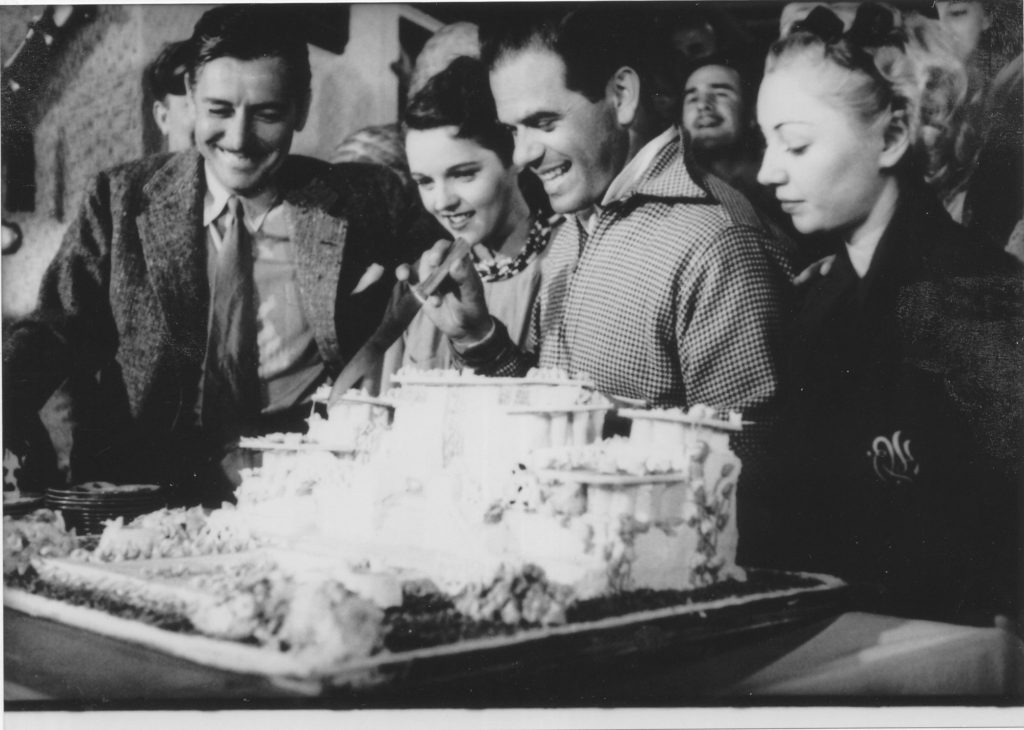
Here are some rare stills from Frank Capra’s “Lost Horizon” (1937), directed by Frank Capra. That’s Mr. Capra behind the movie camera (right top) and his head cinematographer Joseph Walker is behind the blimped camera on the left. That’s Jane Wyatt as Sondra Bizet posing on the balcony of the Lamasery, designed by Stephen Goosson, in the second photo from the top. That house was put up near Hollywood Way in North Hollywood and evidently the exterior still survives. Perhaps Ronald Colman, Jane Wyatt, Frank Capra and Isabel Jewell are celebrating the completion of principal photography in this photo, as they dig into a cake baked in the shape of the Lamasery. I hope one of my readers can tell me if these photos have ever been included in books about “Lost Horizon”.
2019 seemed about 5 years long without my brother. He and his girlfriend Linda were so generous to give me many fine books and stills like the ones here. But Kurt was so much more than just a collector. To say I miss him is not enough, he was a living reminder of our childhood in St. Louis, Missouri. With him died many memories and a big piece of my heart and soul. Again, at the risk of alienating readers of the Catblog, I say God rest you, kind and funny brother. Your memory will be with me forever. Look for more chapters of “Kurt’s Corner” coming up.
Remember that you can enlarge the pictures by resting your mouse line on the image, pressing the “Ctrl” key, holding it down, and then press the “+” or “-” keys to make the image bigger or smaller.
Moving the Island
In this post, “Racketty Ann and the Lost World†reaches it’s fifth and final chapter. My favorite page is number 18, as Racketty Ann confides to her captivated audience, that she “moved the island.†I love the lightly inked dinosaurs in the clouds over Racketty Ann’s head and the bold darkness surrounding the raccoons at the bottom of the page. Note the confused expressions on the raccoons faces at the top of page 19 as they try to figure out “How Can You Do That?†and “CAN she do that?†The next panel on page 19 is a dynamic triangular composition as Racketty Ann declaims to the admiring crowd and their pointy little faces seem to be holding up her airplane. On page 20, Racketty Ann revs up her plane and saying “Gotta Go! I’ve got a summit meeting!â€, takes off for the last time on a mysterious journey. Cathy gets in a subtle gag in the last panel as the raccoons muse about the fate of the dinosaur island: “She probably moved it to MARS or something.â€, and Virgil (or a friend of his) concludes with “She has friends in HIGH PLACES.†In many of her stories, a fantastic premise is gracefully brought back down to normal with a little remark, an understated “shaggy racoon†ending. I hope you enjoyed Cathy’s epic story, an exclusive CATBLOG feature!
Felix is from 8-21 to 8-27-1933 this time. The Dooits visit to the farm is coming to an end, as Felix tries to make the boarders feel at home, farm style. In the 8-26, Danny is afraid his beloved cat will be left behind in the move back to the city, so he puts old fashioned luggage decals all over Felix’s body. The 8-27 Sunday page is full of funny drawings as Felix and Danny get side-tracked to the Circus on their way to the grocery store. I love those wacky heads of Felix that Otto Messmer drew for the “Felix Movies” toy that’s on top of the page.
Myrtle, from 5-23 to 5-29-1949, continues Myrtle’s fleeting romance with rich kid Walton. I love the 5-23, which contains a rare moment of sentiment as Myrtle hugs Bimbo to comfort him after Walton refuses to shake hands with the sensitive canine. The 5-28 again features Myrtle’s bi-sexuality as she nearly becomes a he as she disrobes to put on a boy scout uniform, and Sampson tops her by putting on her dress and hat complete with braids! In the Sunday page, 5-29, Hyacinth the cat appears in both panels as Freddie tries to get Arnold to sneak out to a golf match by putting on false whiskers to fool his wife.
Krazy from 12-13 to 12-25-1943, features the never ending battle of wits between Offissa Pupp and Ignatz. They try disguises in the 12-14, Ignatz tries to look like his portrait in the 12-15, and in the 12-16 Iggy tries to manufacture a brick in a mold right in front of the confused Pupp. The 12-20 to 12-25 strips feature a wacky woodpecker. Perhaps Garge saw a Woody Woodpecker in a cinema in 1943. Herriman’s woodpecker taps a hole in Krazy’s door, taps an iron tree trunk, taps Offissa Pupp’s wooden head, and makes iron and clay sculptures of himself to fool the Pupp. The Officer’s Christmas present to the woodpecker is to throw him in jail with Ignatz. “Kwee Pippils, them Wood Peckas”, says Krazy.
BOOK REVIEW:
Boffo!
You will enjoy reading Bill Griffith’s graphic novel biography of Schlitzie, the famous pinhead, star of MGM’s “Freaksâ€. This book would make a terrific feature picture in itself, you can just see it in black and white with a few color scenes, and maybe getting a real pinhead (or digitally modified) to play the main part. The carnival settings are really well done and well thought out. The ink lines and meticulous attention to the details of the buildings are wonderful to look at. If you are a fan of Carnival or old time Midway subjects-“Freaksâ€, “Carny (1980)â€, “Nightmare Alleyâ€; the details of Schlitzie’s life should be especially interesting. There are intense dramatic moments where Schlitzie gets riled up and says “Y’SEE!†repeatedly. He is at his most monstrous at these points in the story, yet vulnerable. The making of “Freaks†sequence was of course very involving; pg. 100 was especially good as Bill Griffith provides a translation of Schlitzie’s garbled dialog. Pg. 233 really resonated with me, as Griffith draws Schlitzie’s time hanging out in MacArthur Park. I went to Chouinard on Seventh street, which was right across from MacArthur Park and I used to frequent the area quite a bit in 1971, so I could have seen Schlitzie, but sadly, never did. This is a very well done graphic novel and made a very sympathetic character out of a so-called “freakâ€. Pgs. 240, 241 and 242 are a poignant farewell. Did you ever see the old Jimmy Durante TV show? At the end of every show, Jimmy put on a battered hat and coat, wished Mrs. Calabash “Goodnight†and walked away from camera into a dark set lit with star spotlights back to infinity. Schlitzie walking over the stars of Hollywood Blvd. reminded me of Durante’s finale. The die-cut cover is attention-getting as well. Bill Griffith reportedly spent five years working on this book. Quite an accomplishment when you consider the hours he spends each week on the “Zippy the Pinhead†comic strip. Note that Robert Crumb rates this book as “the best graphic novel of the yearâ€, and Mr. Crumb is never too lavish with his praise.
Dino Tears
Howdy Readers, if you want a quick and easy way to enlarge the pictures on the Catblog, just hold down your “Ctrl” (Control) key and click the + (plus) sign to enlarge and the – (minus) sign to reduce them. Remember to HOLD DOWN the Control key while you are doing this. Enjoy!
Here’s part four of Cathy Hill’s unpublished comic story: “Racketty Ann and The Lost World”. Cathy was truly a prognosticator of our current dilemma, as she attributes the dinosaur’s mortality to the human encroachment of their island. She combines comedy, comment and empathy as she uses comic drawing on pages 14 and 15, and a more sympathetic treatment on page 16. The first panel shows a stegosaurus collapsed in the background while a brontosaur looks after her little one in the foreground. In the second panel, Cathy uses dinosaur tears as a mother tyrannosaur looks over her ailing progeny still in the shell. As you wipe away the tears, enjoy the multiple screens of the videographers on page 14, and the intrusion of the buses, helicopters and motorcycles on page 15. Coming soon, the final chapter of this epic tale.
Felix is from 8-14 to 8-20-1933 this time. Felix saves Danny from the forest fire, much to Papa Dooit’s relief. However, Pop’s money was burned in the fire and he faces financial ruin, but Danny gets a 200 dollar bonus from the logging company for saving their logs, so Papa is rescued. Poor Felix, however, is left out in the rain and seeks refuge in an empty boot. The Sunday page continues the adventures of Felix and Danny at the circus, trying to dry clean a bear!
Myrtle is from 5-16 to 5-22-1949 this time out. In the 5-16, Myrtle looks kind of like a boy in the first panel as she lifts weights, then reverts to looking like a girl as she puts on her hat with the braids attached. She does this to impress “Walton”, a very rich boy who likes “proper” behavior. Myrtle starts to loosen him up by 5-21, as they are both blowing bubbles in their sodas. The Sunday page features a beautiful Fisher layout, as Freddie spray paints Myrtle, Sampson, Hyacinth and even the little Myrtle doll, much to Susie’s horror.
Â
Krazy, from 11-29 to 12-11-1943, is mostly non-continuous gags this time, I like the reference to Kayenta, in the 12-7, and the feline subtext in the 12-10, as Krazy “puts the light out” by placing the lamp on her back porch, in a beautiful panel using intricately cross-hatched blacks to reveal Offissa Pupp’s bewilderment. You will note that the 12-4 to 12-11 strips are a bit taller, that’s because I got them from the San Francisco Examiner, which was one of the few papers to run the Krazy Kat strip in the 1940s, and probably the only one to run the full panels as Herriman drew them. Again, these panels show the little Coconino theater that Garge imagined, the little stage with the floorboards exposed, like in the 12-8 and 12-9. The KFS files don’t have the un-edited panels, but you will see them here in the Catblog!
Kurt’s Corner
Here are more stills from my late brother’s library and his extensive files on Clark Gable. I chose these because they feature Mr. Gable’s checkered career on network radio. This one features Clark and Virginia Bruce performing the Oscar-winning motion picture “Cimarron” on the Lux Radio Theater, 9-26-37. Cimarron won best picture in 1931, and was the only Western which achieved that honor until “Dances With Wolves” in 1990.
From that same year, 1937, here’s Clark on NBC, probably the Chase and Sanborn show, with Edgar Bergen and Charlie McCarthy. This would have been for the 10-17-37 broadcast, featuring the Stroud twins. This program still exists! Do a search for it.
I’m not sure of the exact date of this great photo of Mr. Gable, but it is probably pre-World War 2. Clark seems to be very happy in this shot, maybe he enjoyed performing on radio, no make up necessary!
And last but not least this time, a rehearsal shot from the Burns and Allen show of 11-21-46, even though the photo is dated 11-26. This was Clark’s first network radio appearance since his World War 2 service, and he seems happy to be performing again. Sadly, this show has not survived, but maybe a collector has it on a reel to reel tape somewhere. “The Hucksters” was Gable’s second MGM film after his return, and he didn’t like the novel the screenplay was based on, saying “It’s filthy and it isn’t entertainment.” Read more about the picture here.
Â
Close Up On The Eggs
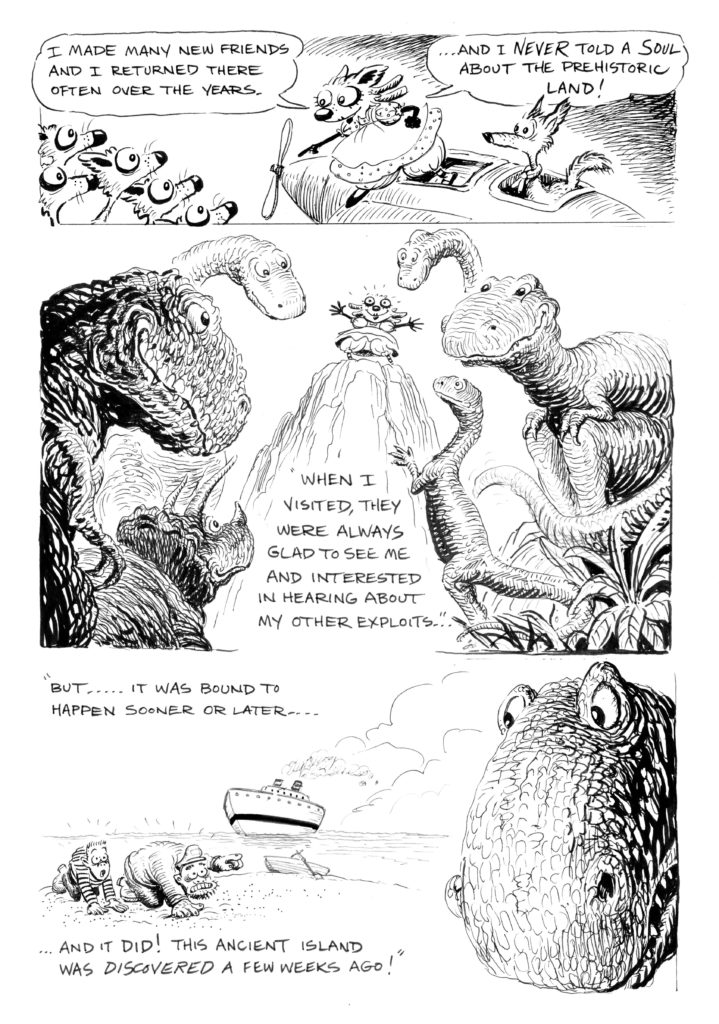
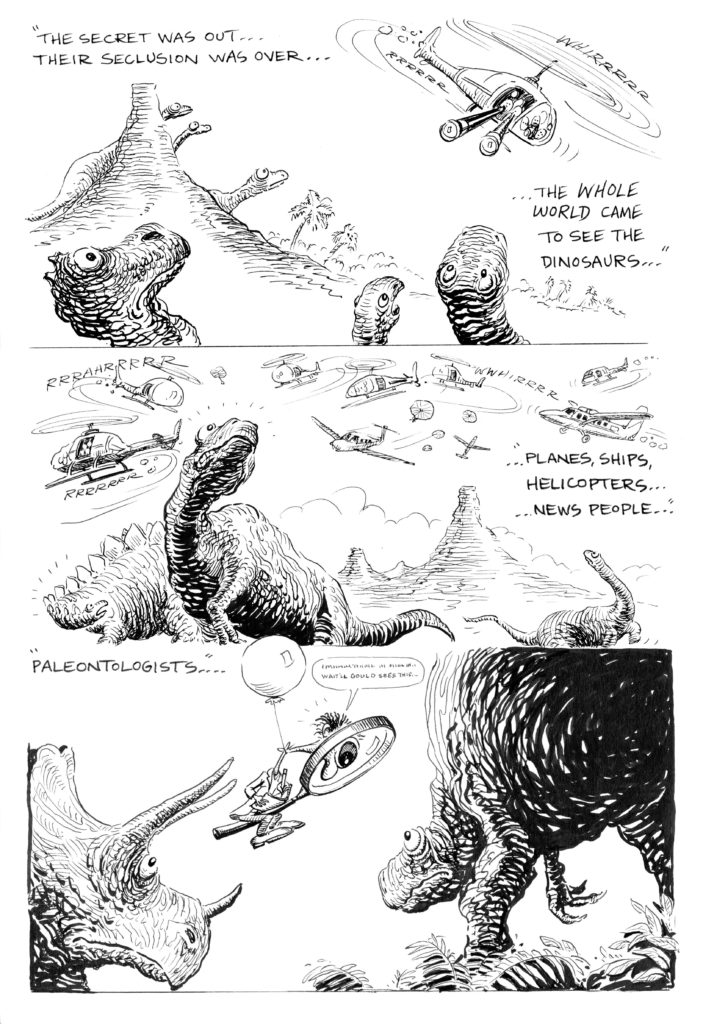

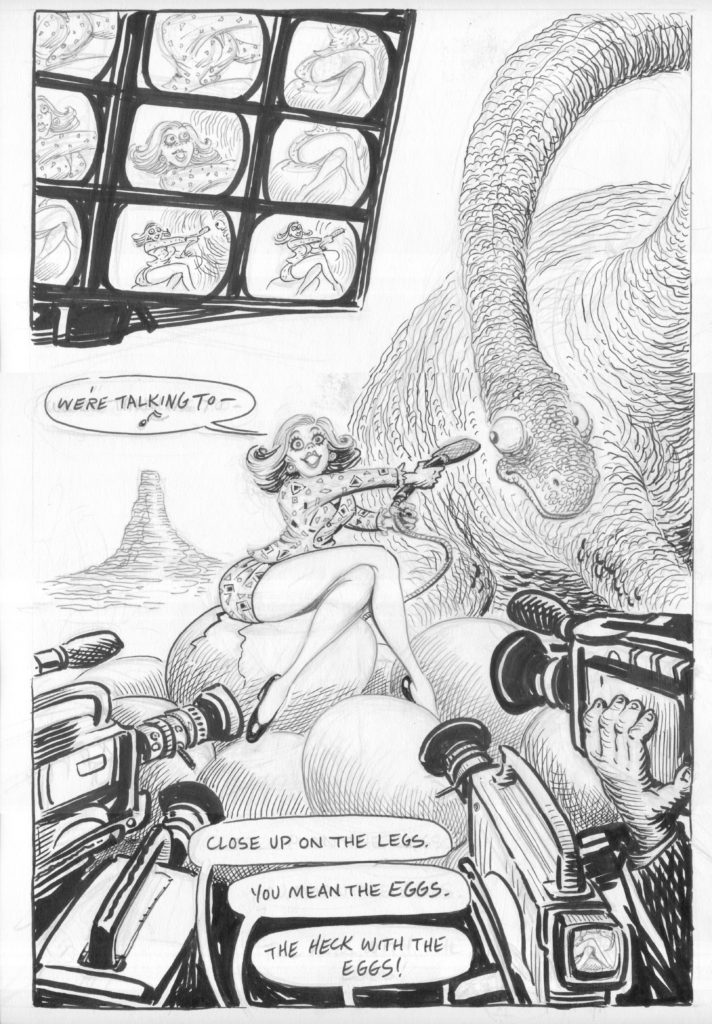
Here’s the third part of Cathy Hill’s epic story: Racketty Ann and The Lost World! In pages 9 through 12, Racketty Ann continues her story (I love how the dinosaurs want to listen to her) of her trips to the prehistoric island. The secret is suddenly out when some sailors land on the beach, and the news media descend in pesky profusion. I love page twelve as the videographers are torn between focusing on the dinosaur eggs or framing the tapering limbs of their pretty newscaster (just look at the monitors at the top of the page to see just how torn the videographers were). Cathy loaded these pages with downshots and upshots of the dinosaurs really highlighting their immense bulk; the shading and variety of the line weight helps the effect. The progression from fine lines in the background to heavy lines in the foreground is most evident in page 12. The little paleontologist on page 10 has a Rube Goldberg touch as he rides through the air astride his magnifying glass with his neck nearly snapped in half by a helium balloon.
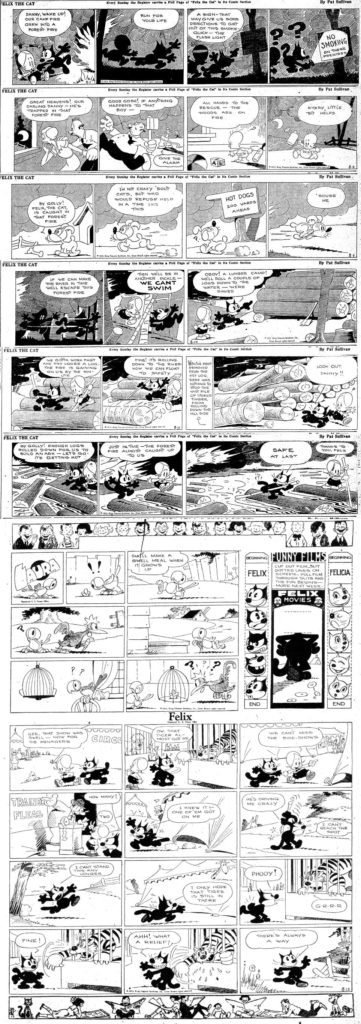
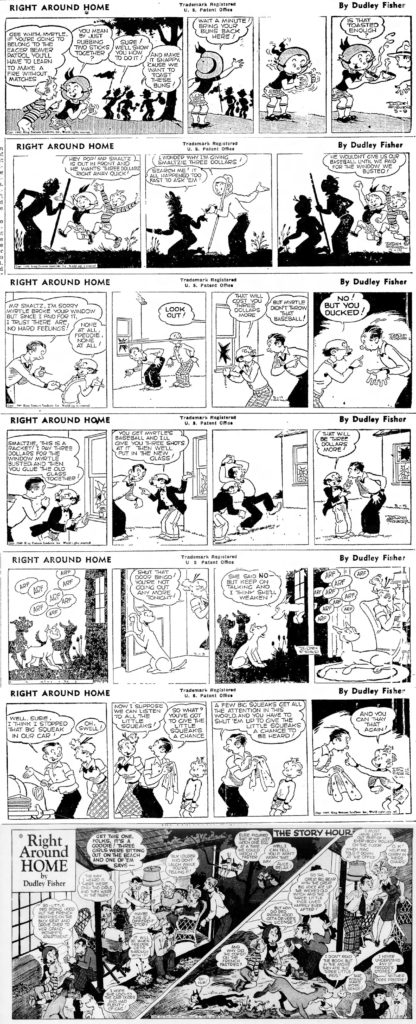

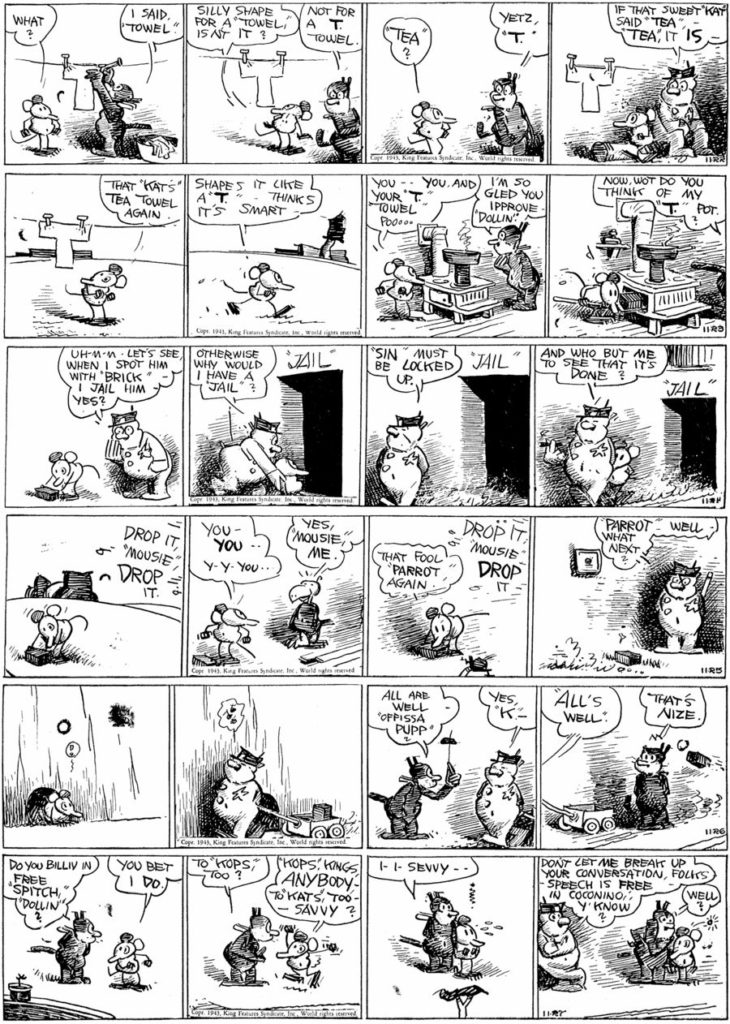
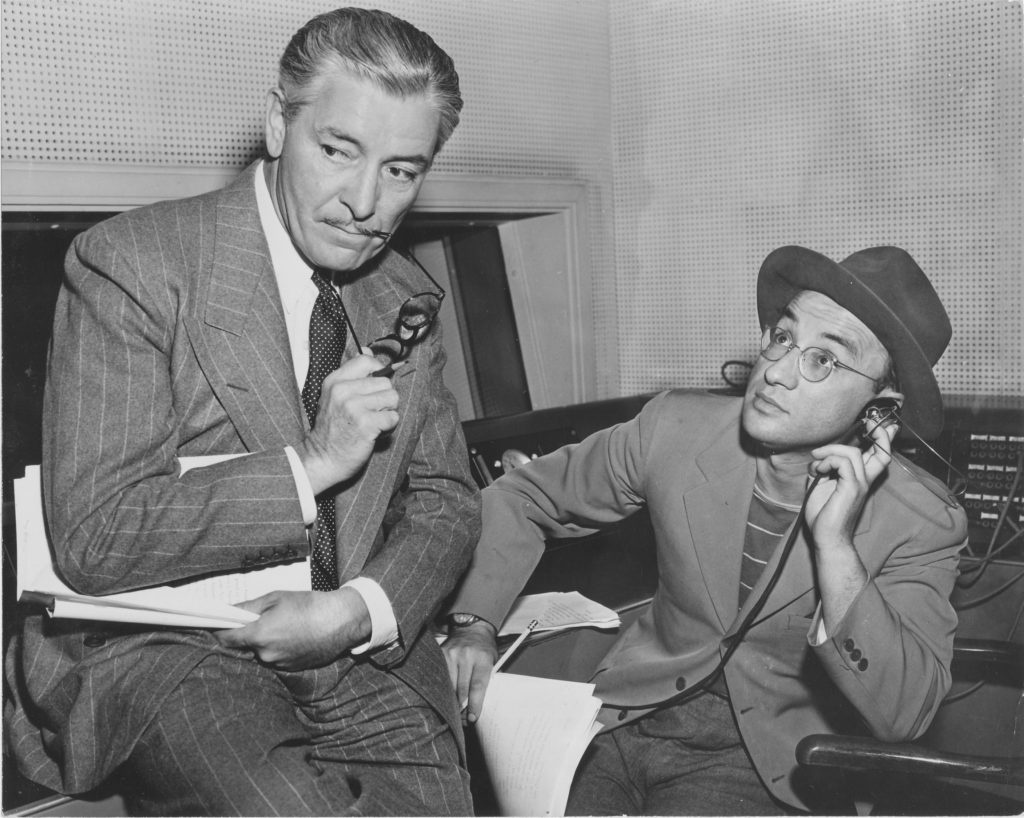
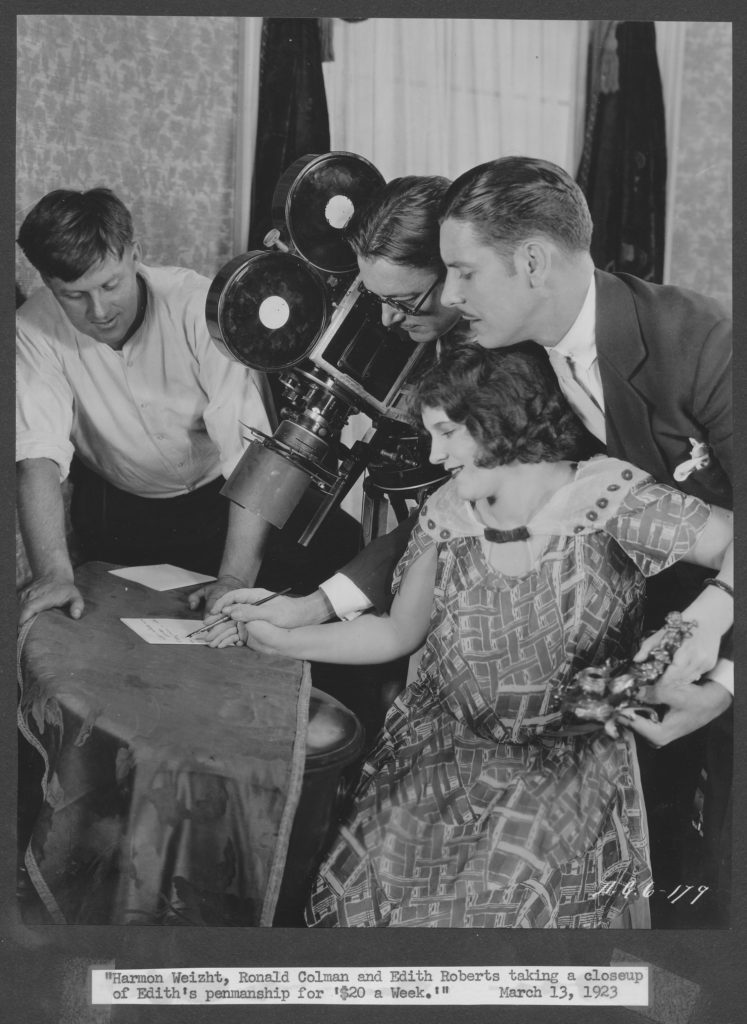
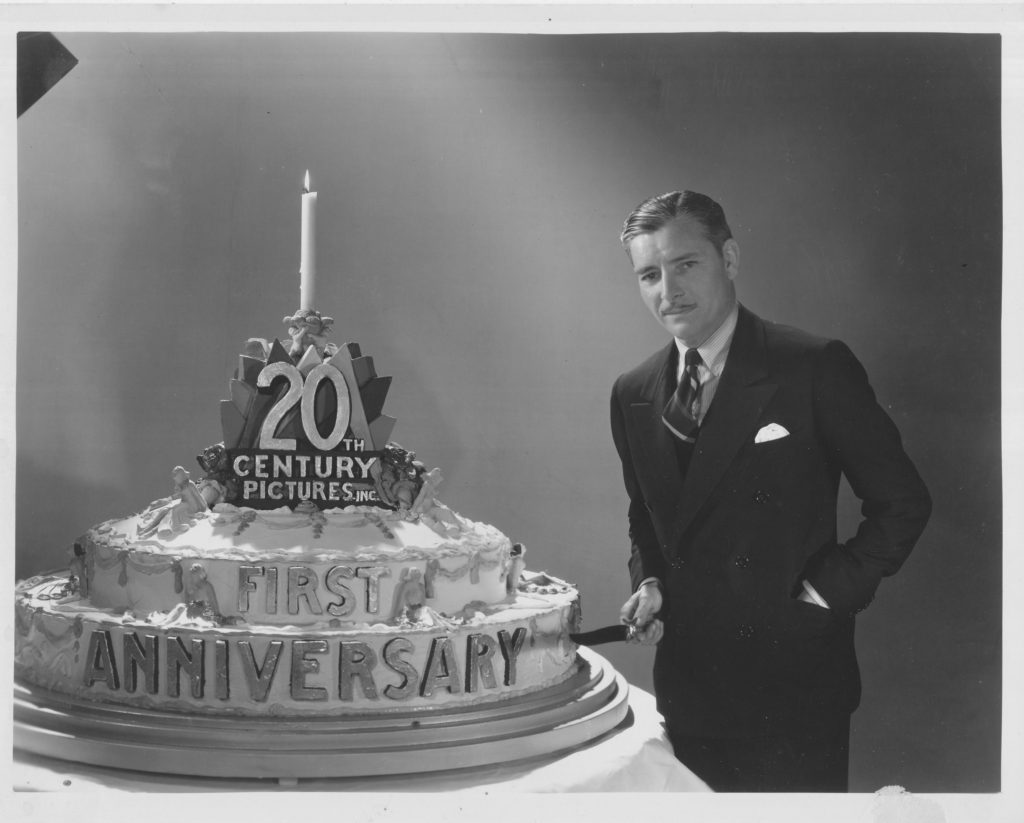
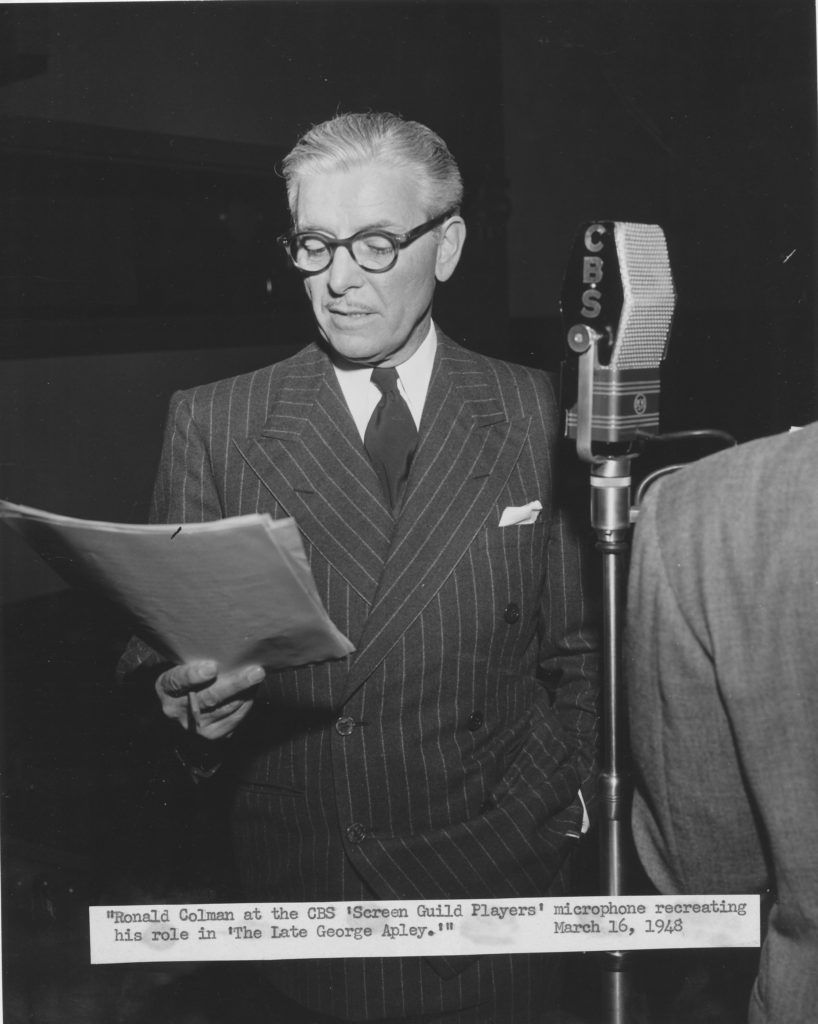
Racketty Ann’s Mystery Flight!
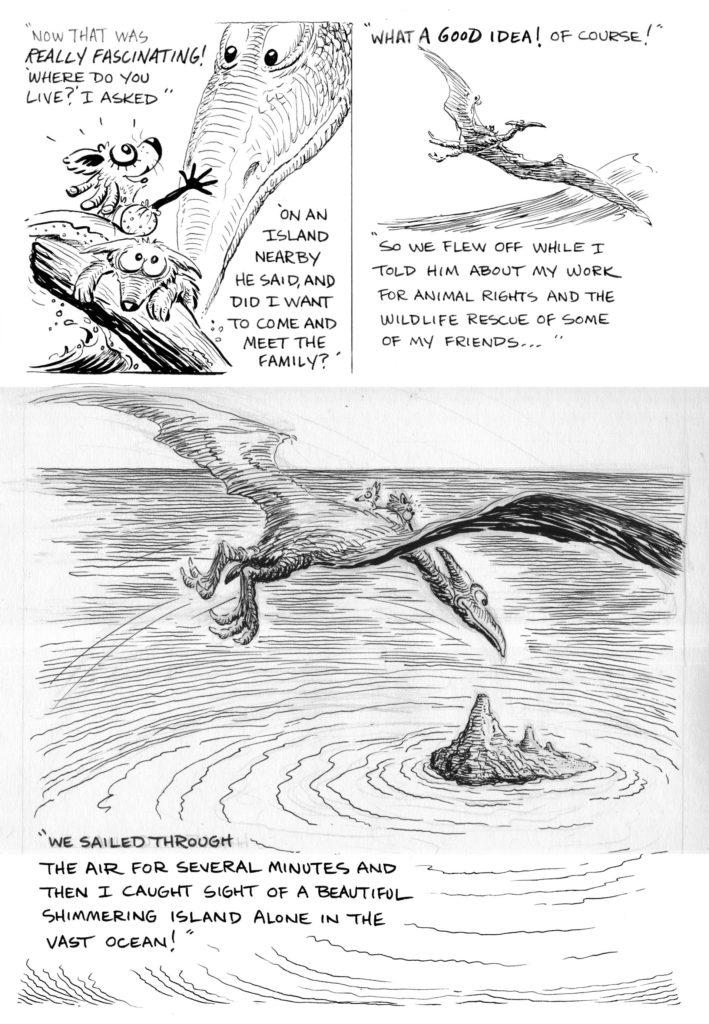
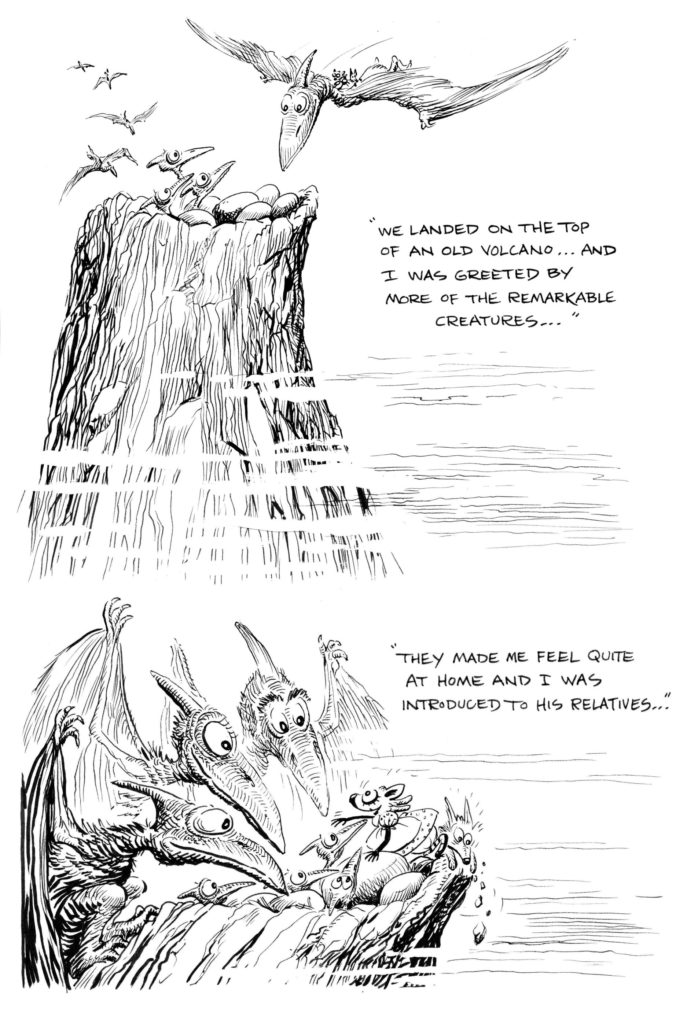
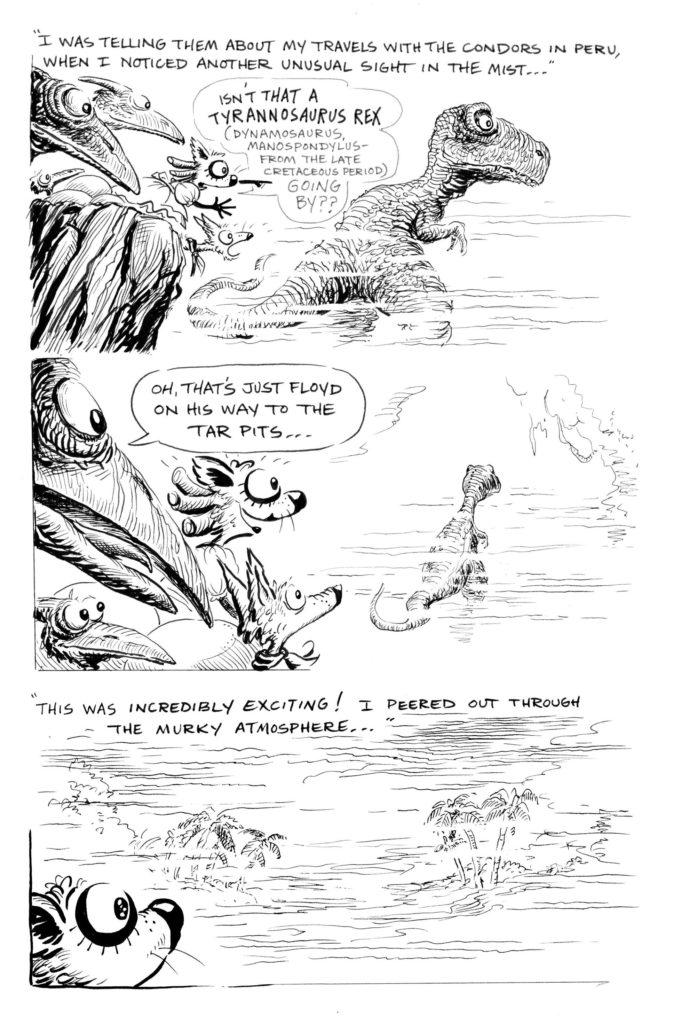
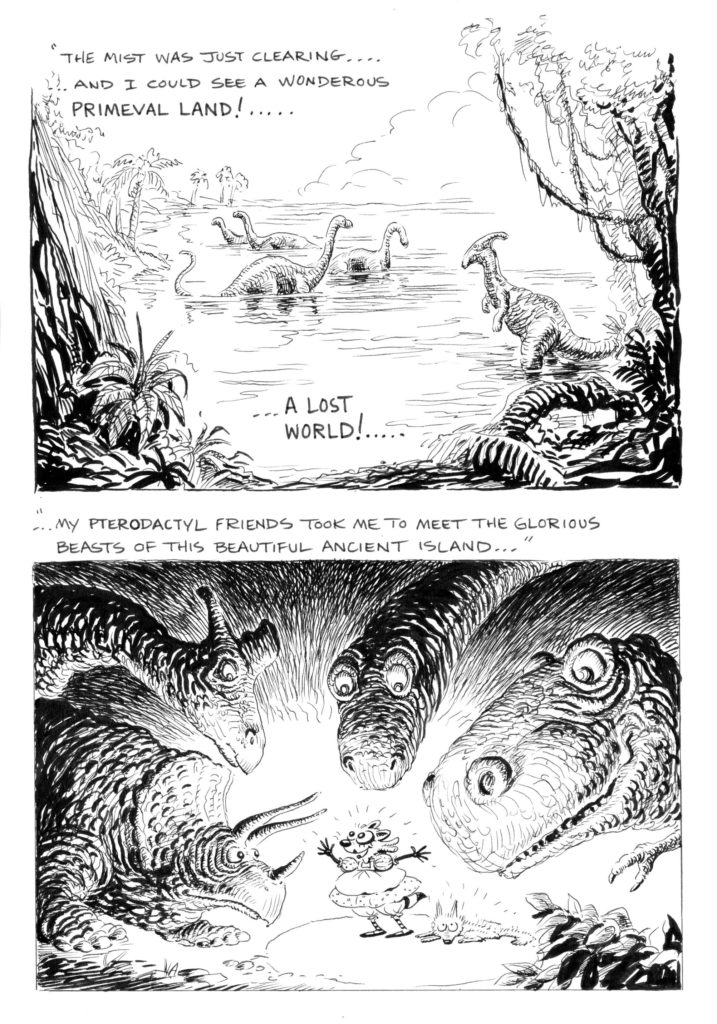

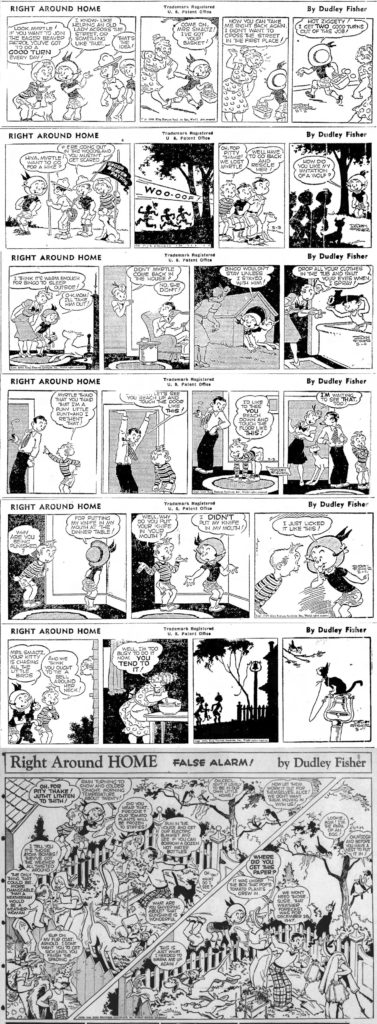
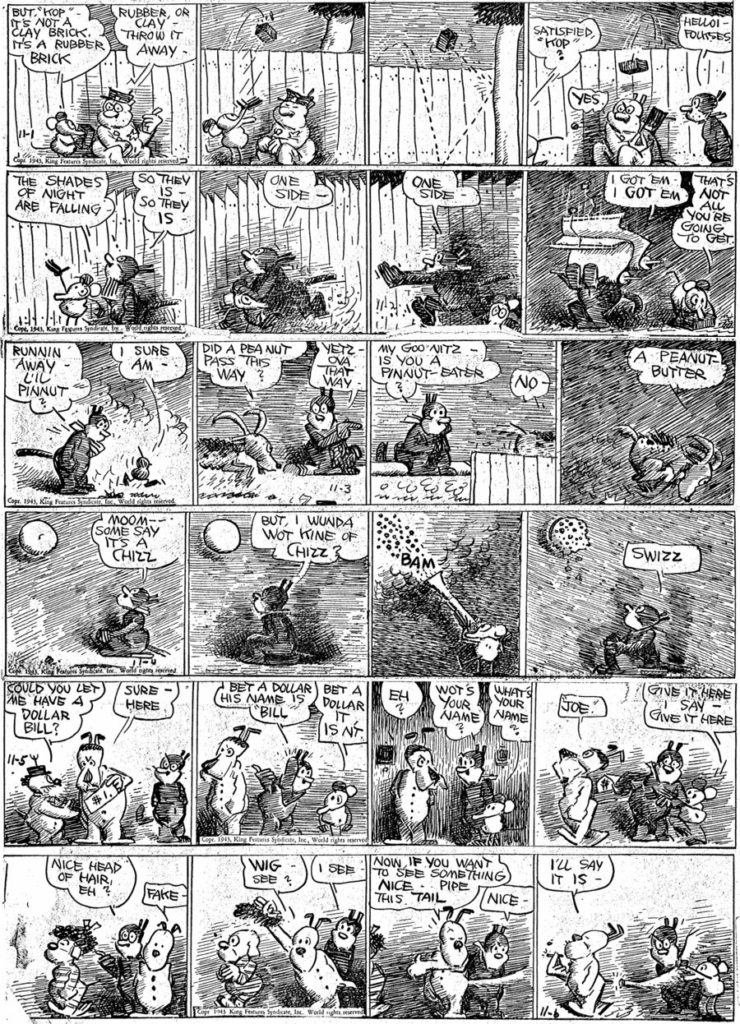
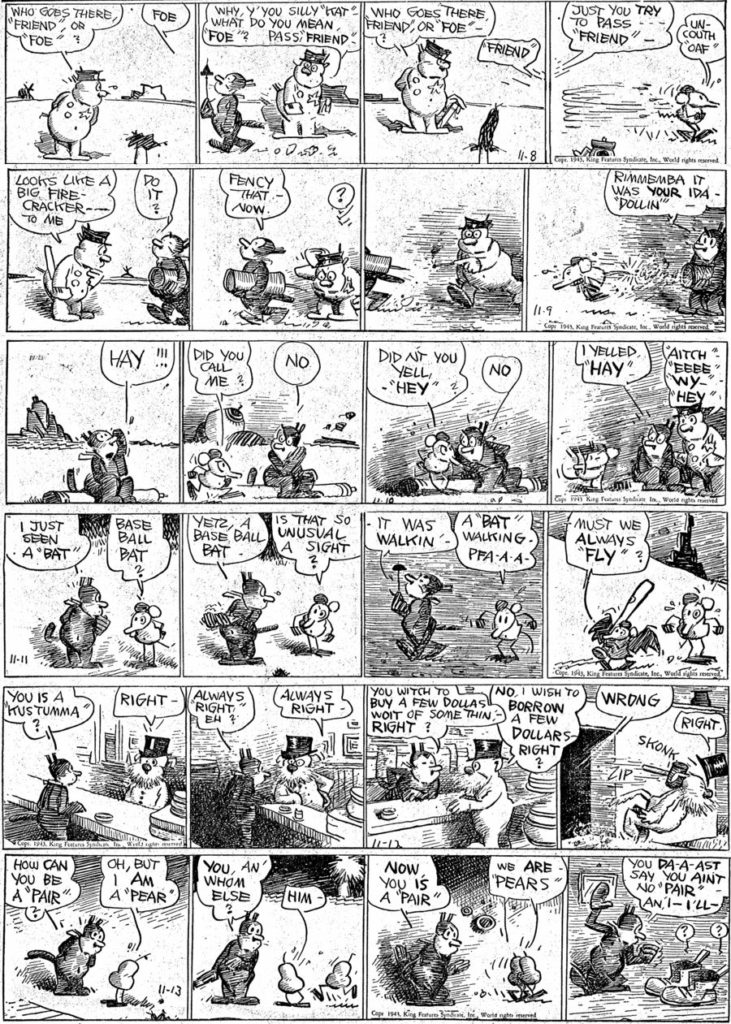

In this installment of the ongoing tribute to my late brother, I present some more Clark Gable rarities from his wonderful collection. This time Gable shaves off his famous moustache as he enters the Army in 1942 in an amateur snapshot never published. Gable eventually entered Officer Candidate School in Florida and below you will find the graduation program and a copy of his address to his graduating class (autographed). Note that it reads something like one of the characters he played in the movies: “Gentlemen, I’m not going to say to you ‘get on the beam’. You’re on it. The job is to stay on the beam until–in victory–we get the command; ‘Fall Out’ “. I can hear his voice as I read the text of this speech.
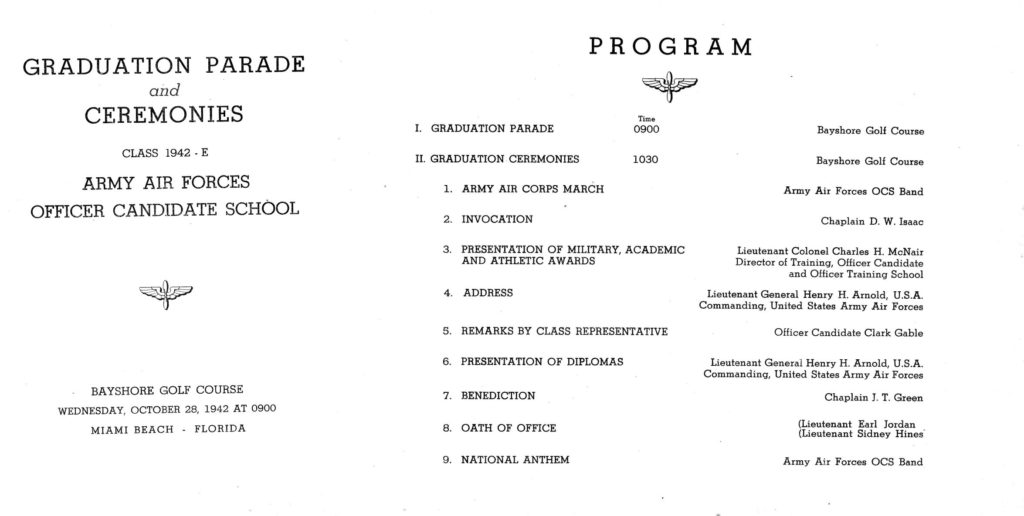
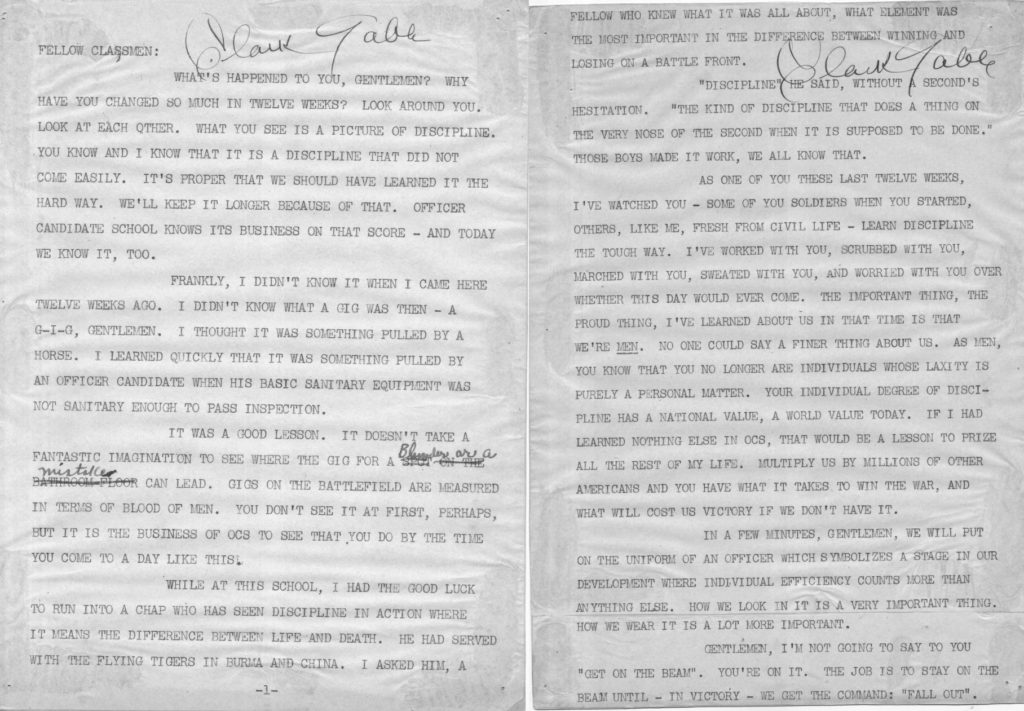
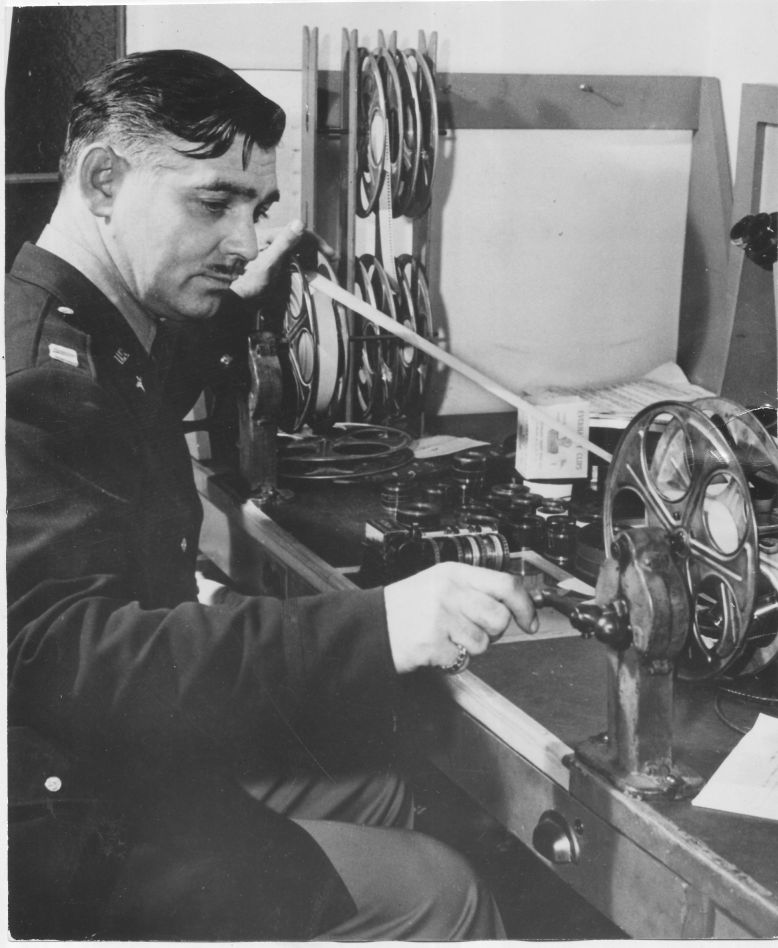
Remember Folks to click on the images with the right button on your mouse. You will see a menu that says “Display image in another window” or “another tab”, or just “View Image. Click on that and you can make the pictures much larger. Thanks for taking the trouble to read the catblog and enjoy the pictures.

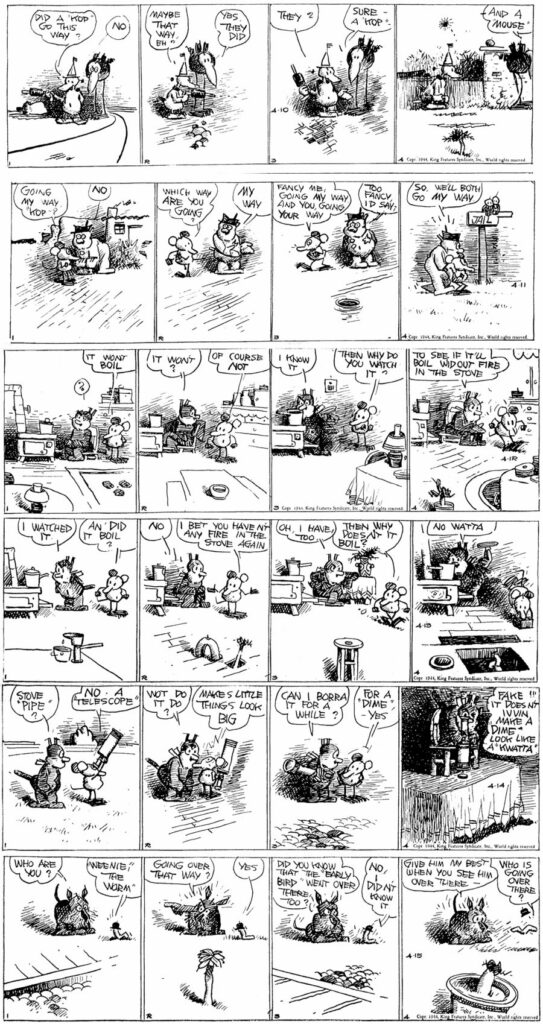

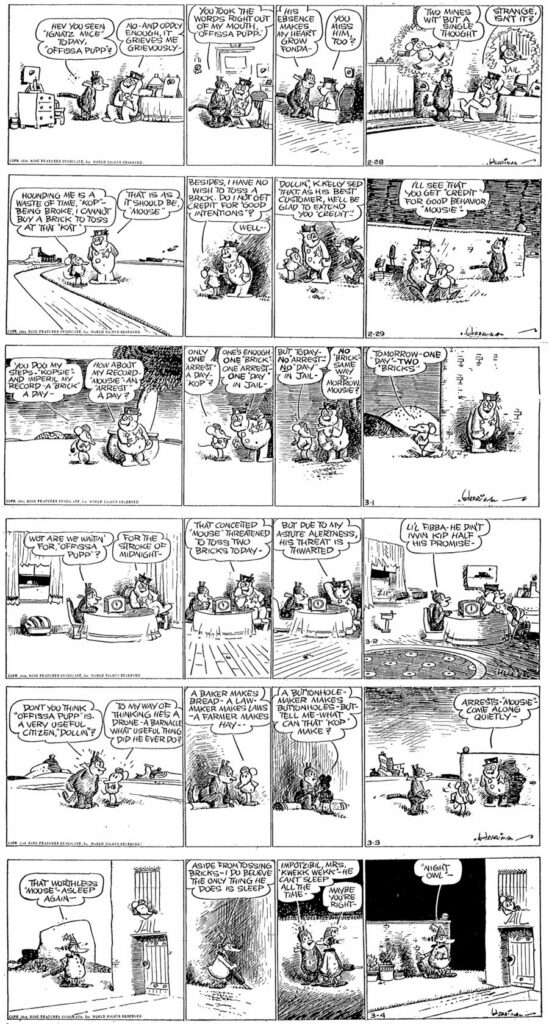
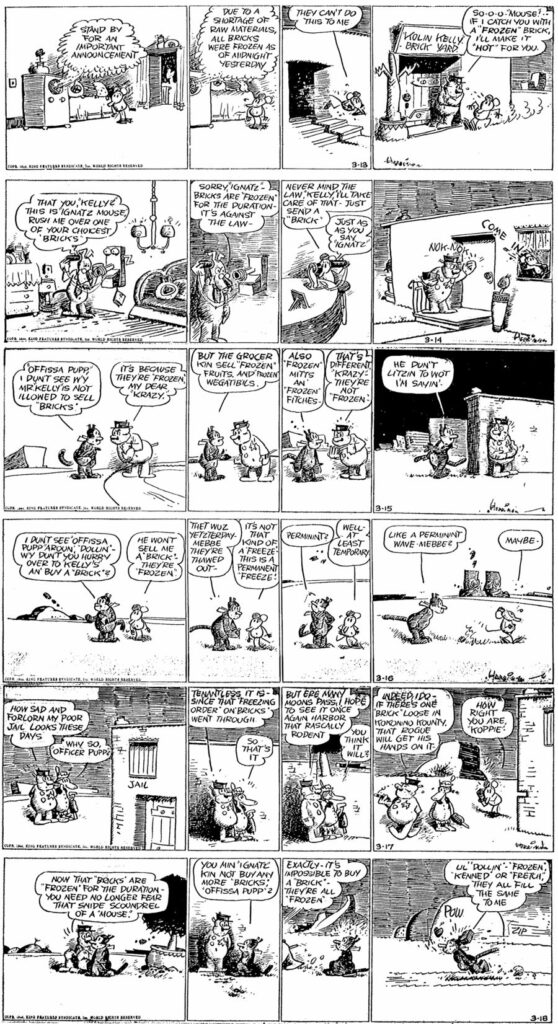
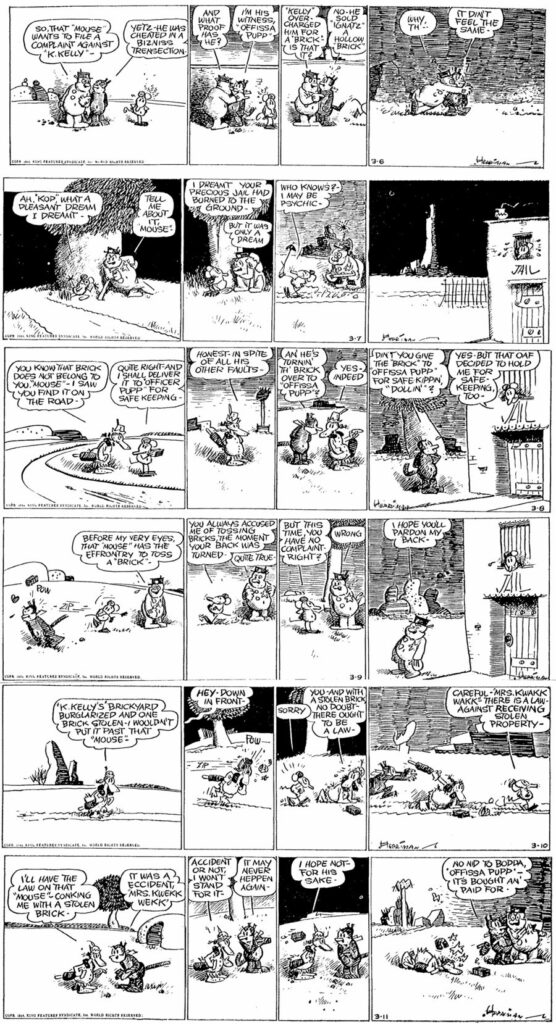

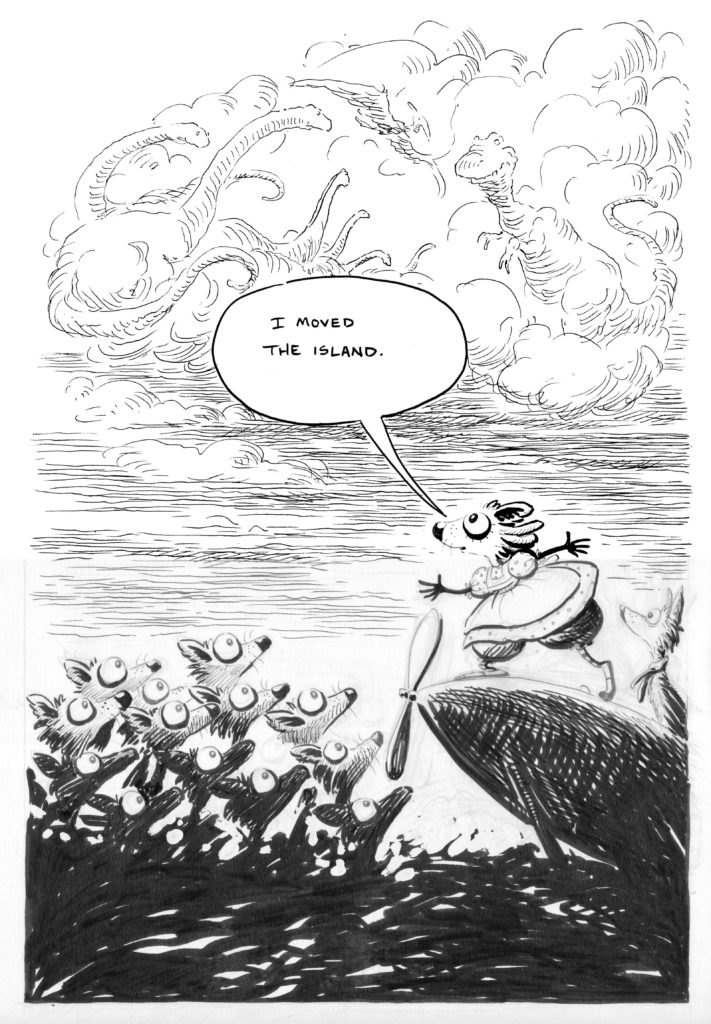
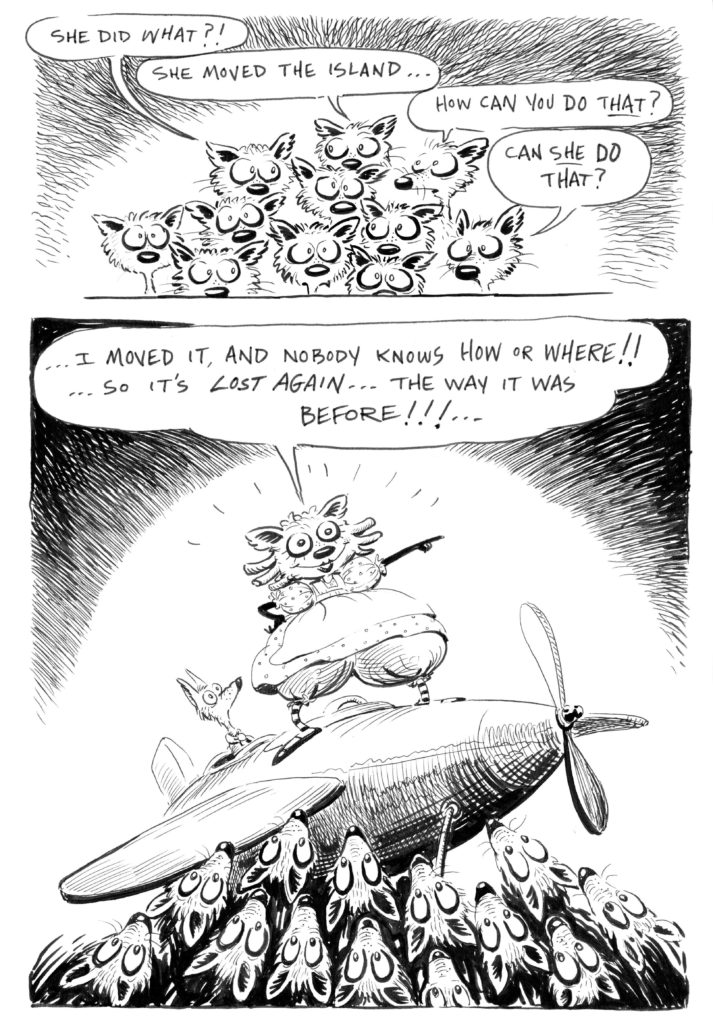
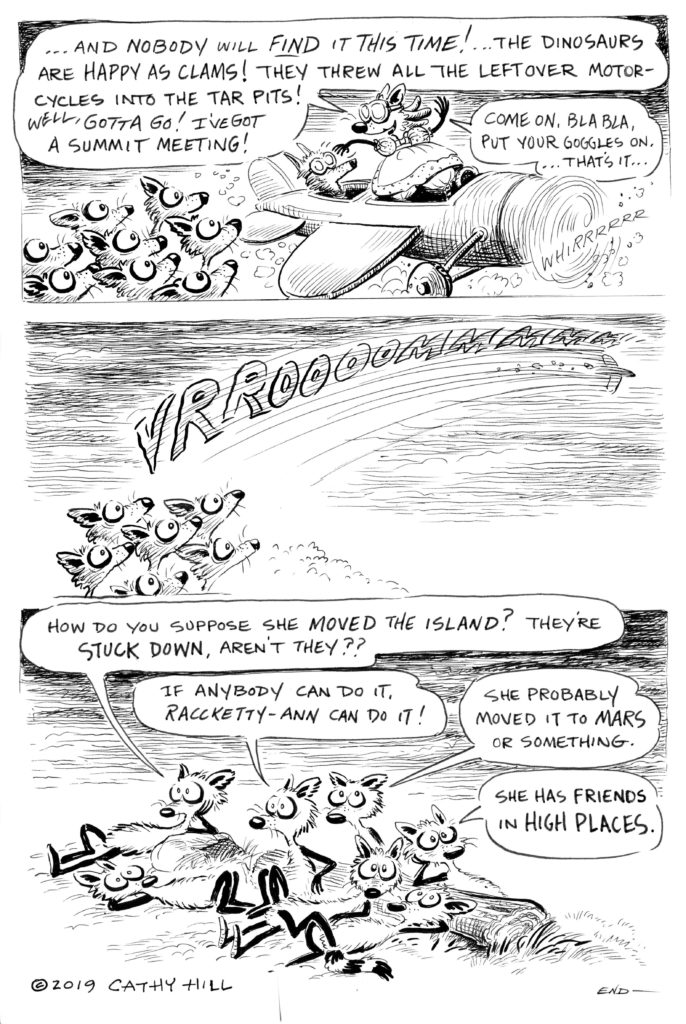
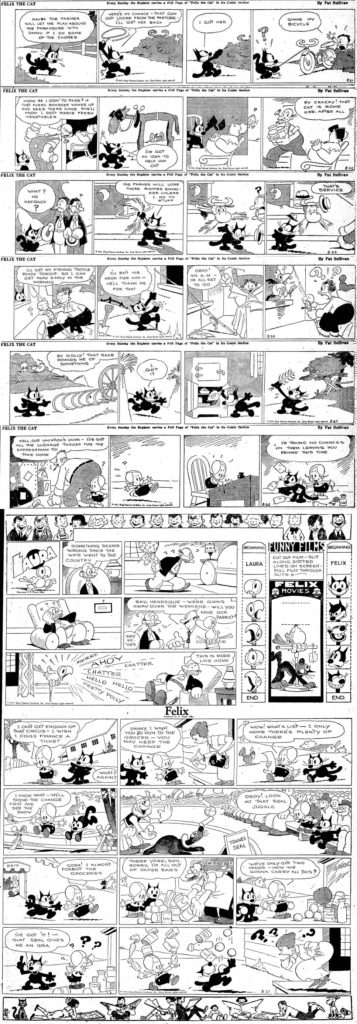

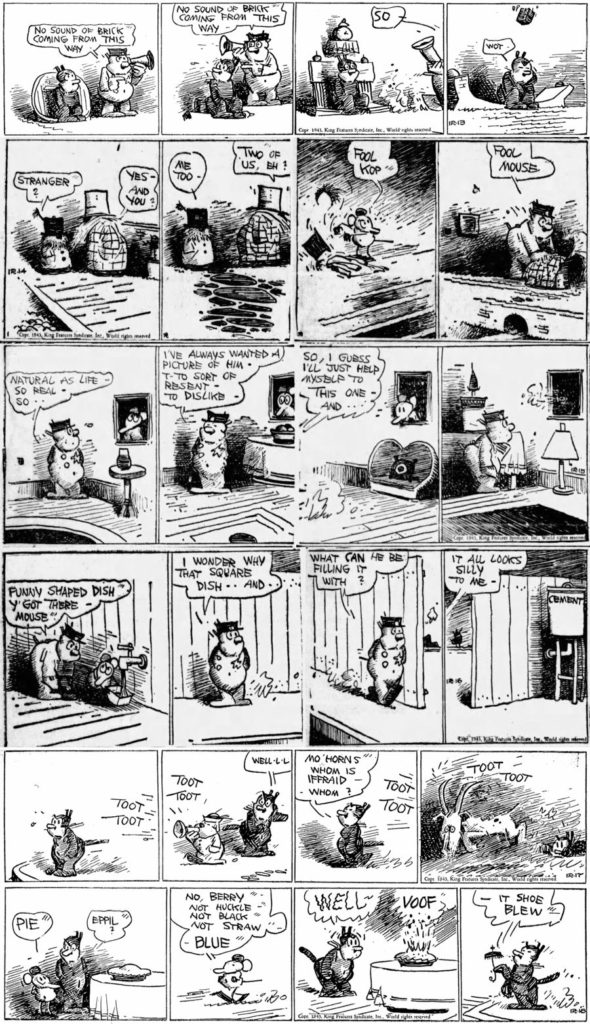
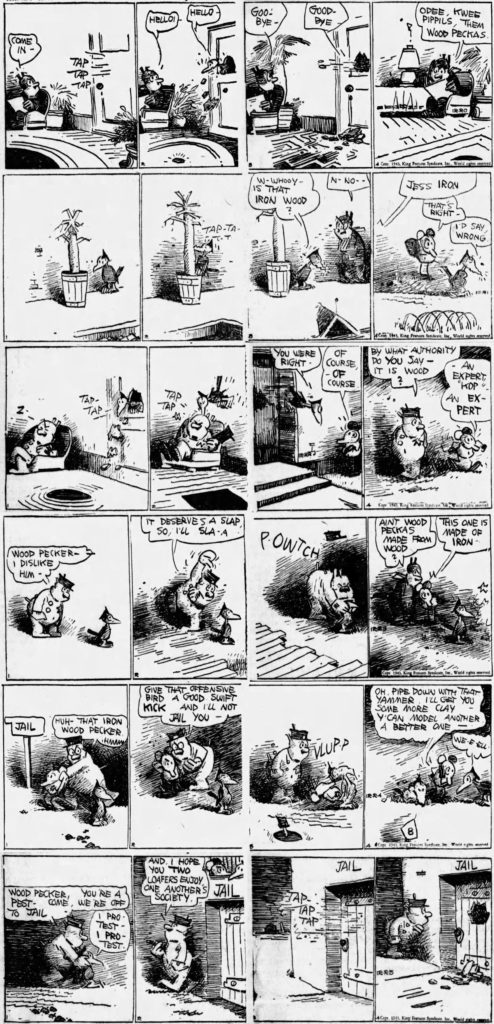
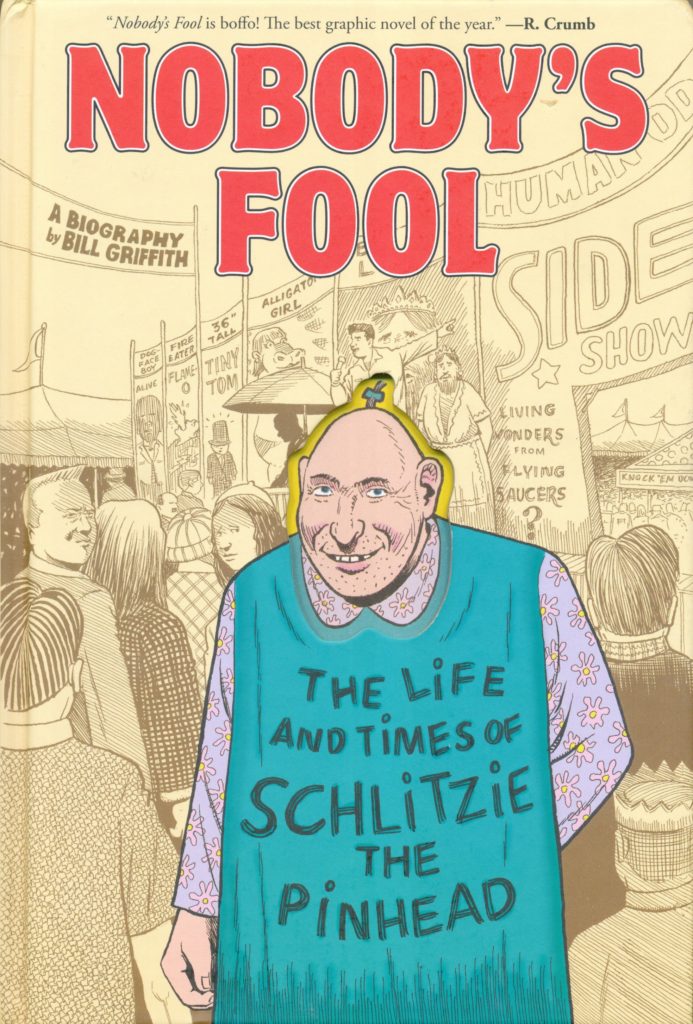
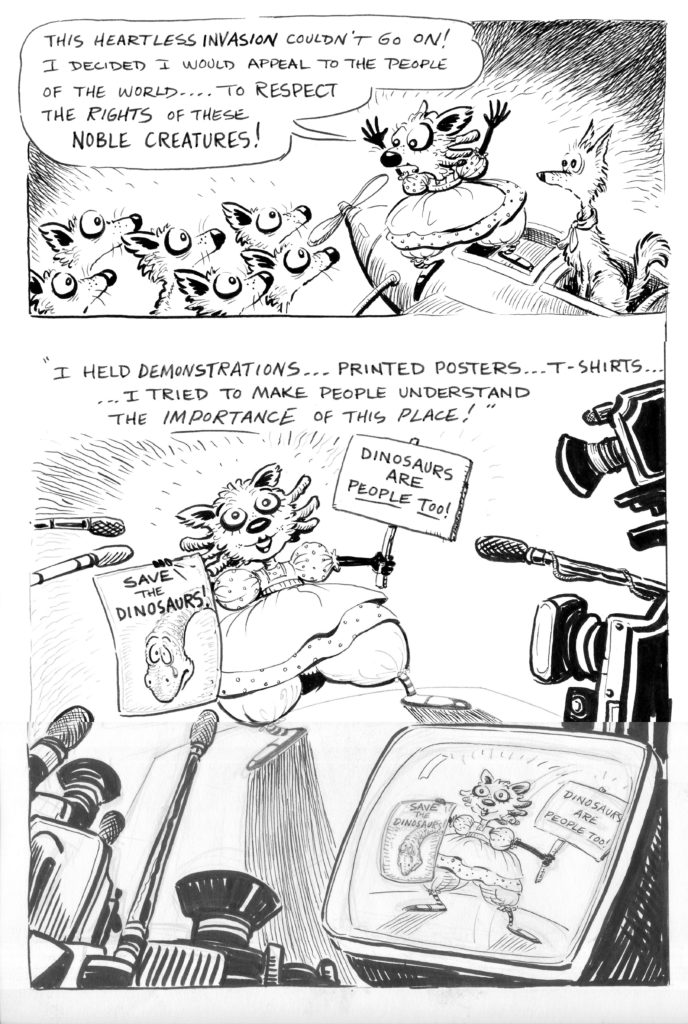

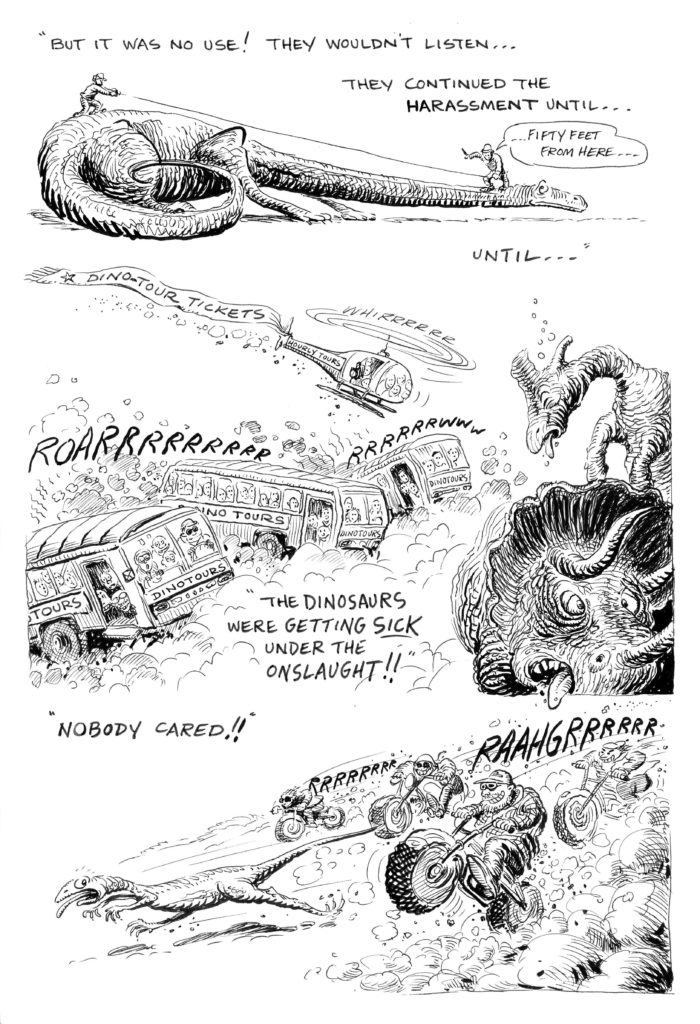
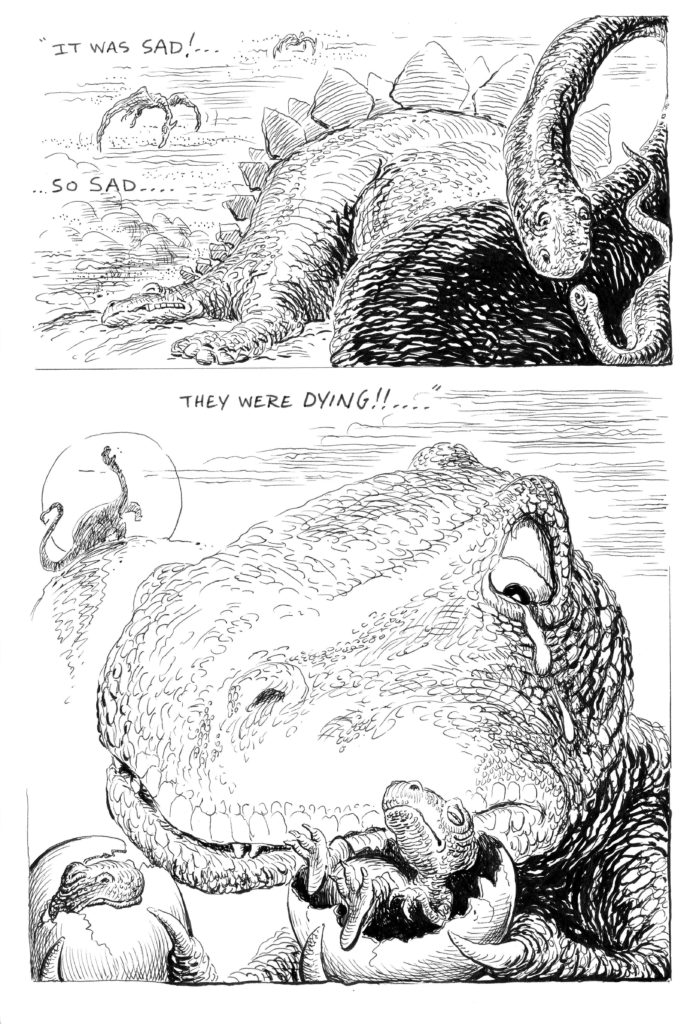
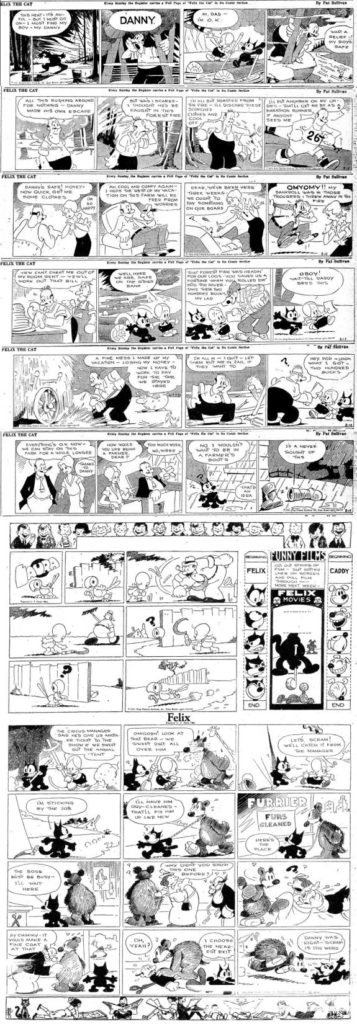
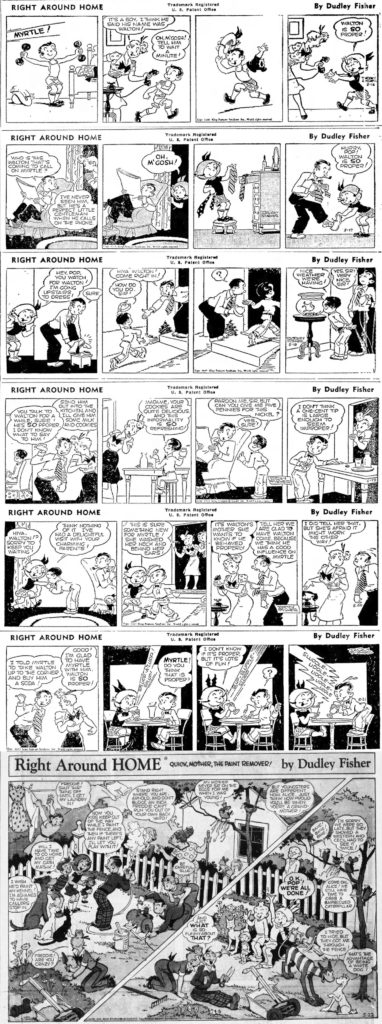

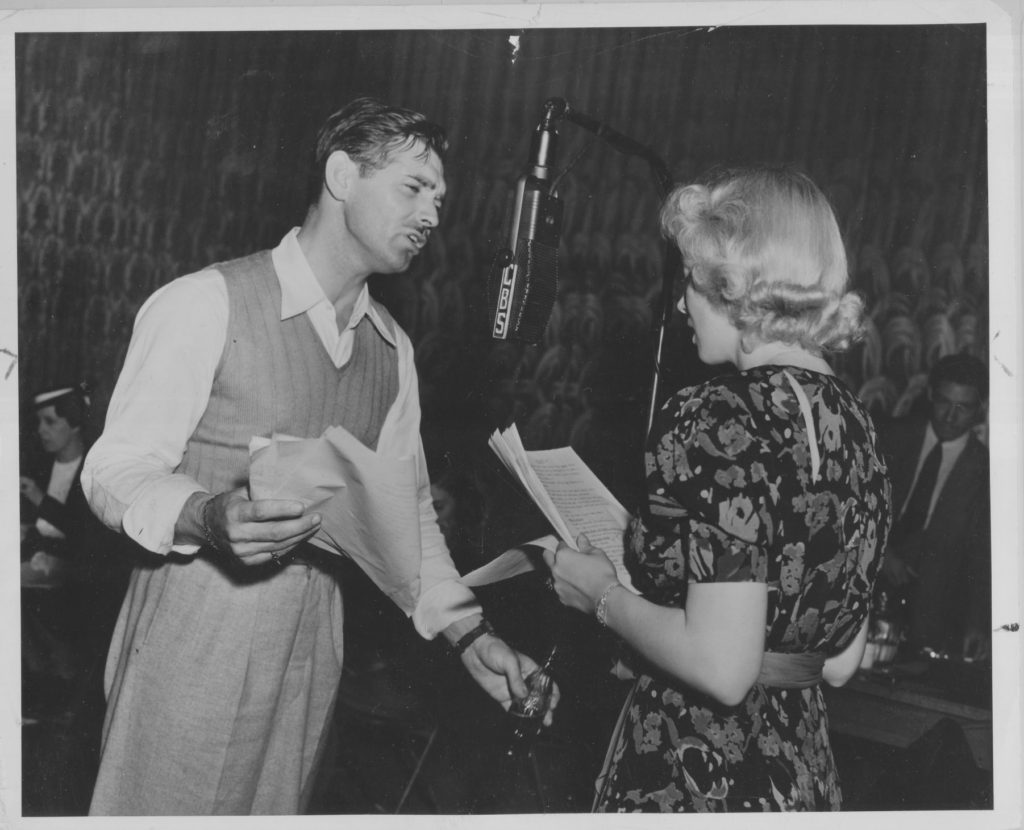
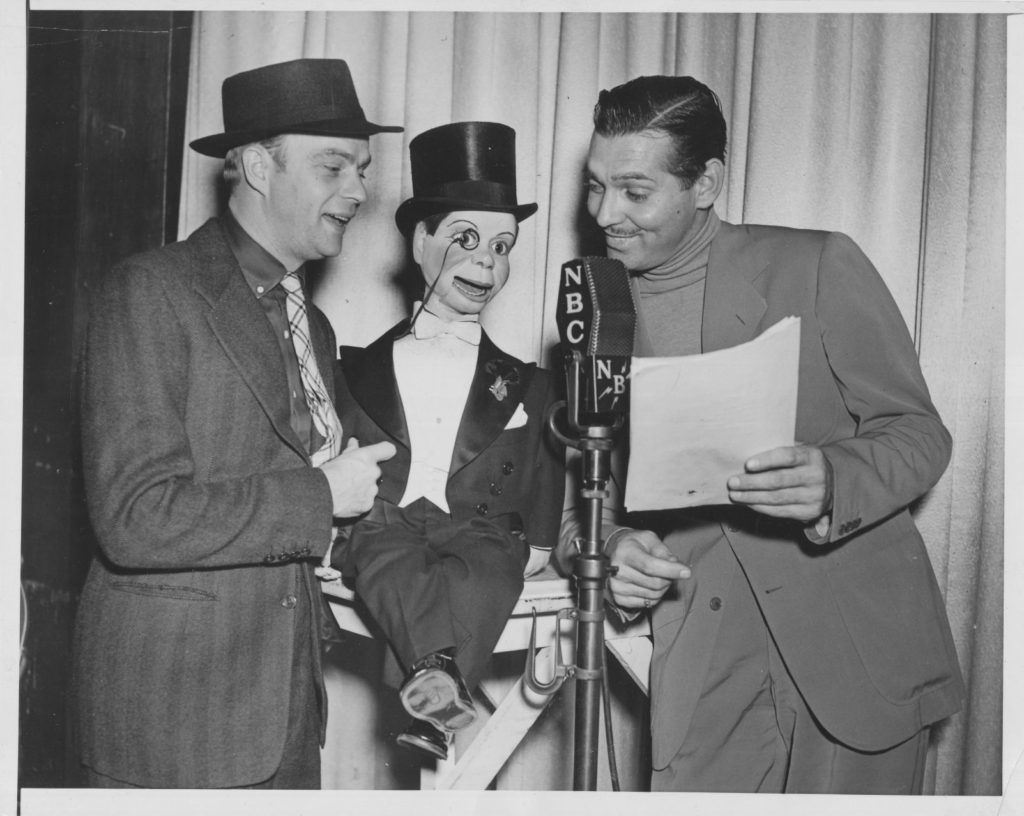

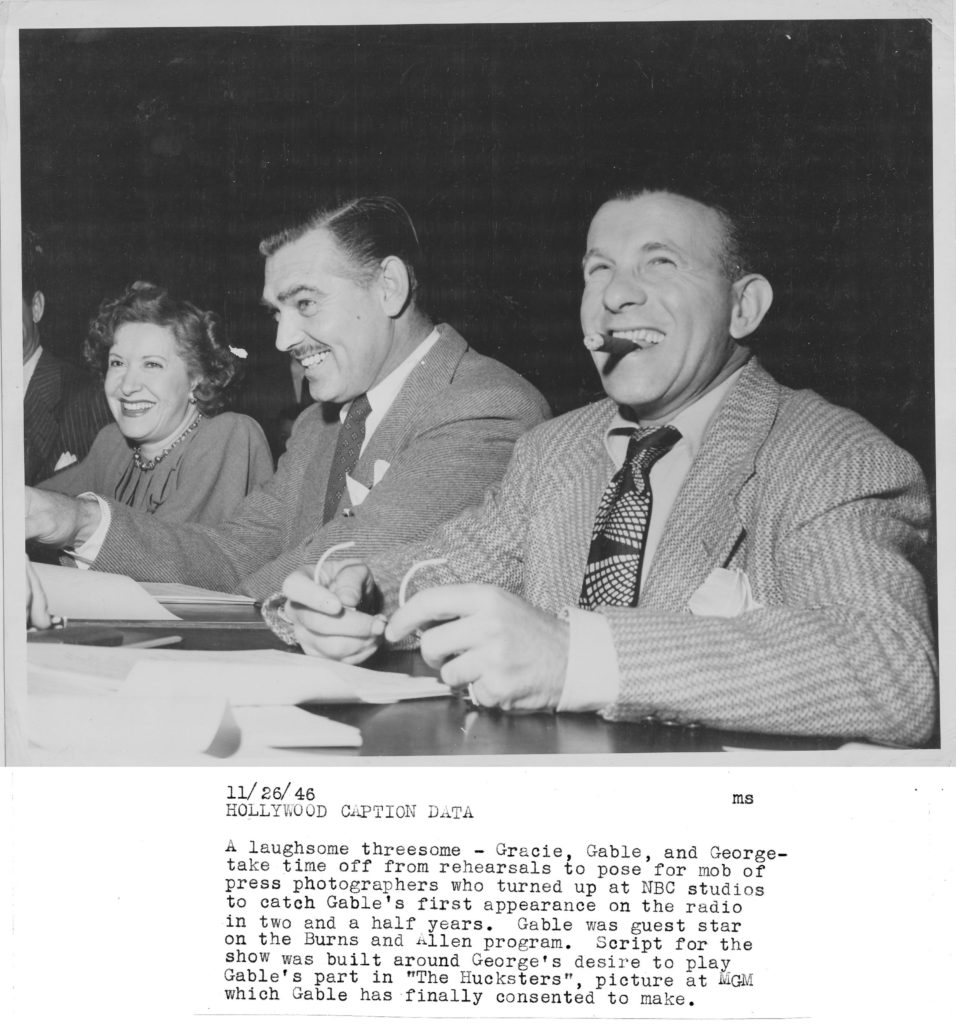
Mabel Can Only Be A Sister To Jimmy
January 29, 2024
Comic Strips George Herriman, Uncategorized
2 Comments
Mark
Here, dear readers, is the return of George Herriman’s “Now Listen, Mabel” from 6-9 to 6-21-1919. The strip started April 23, 1919 according to comic strips historian Allan Holtz. A good friend has found some of the earlier episodes of Mabel and is sharing them with us. In the 6-10 strip, the phrase “Now Listen, Mabel” is uttered by a handsome stranger who takes Mabel away from Jimmie and his rival. There might be more such uses of the strip’s catchphrase if we ever find the first month and a half or so of Mabel. Jimmie Doozinberry, as in the rest of the Mabel dailies, is constantly frustrated by Mabel’s seeking safety in numbers and relentlessly playing the field with many rivals for Jimmie’s affections. Mabel just wants to be a “sister” to Jimmie and a parade of other men. Jimmie in desperation talks Mabel’s brother Tom in to adopting him as his brother, thereby becoming a brother to Mabel as well with full visitation rights. We’ll see how that turns out in time. If you seek out the post, “An End and A Beginning”, you can see the earliest “Now Listen, Mabel” dailies published by the San Francisco Examiner, starting 7-28-1919. The Catblog will try to fill in the gap in Mabels from 6-23 to 7-26-1919 very soon. A Happy New Year to you all.